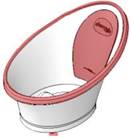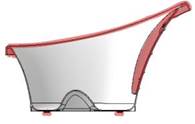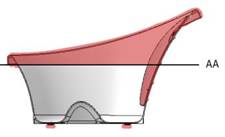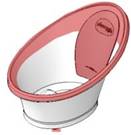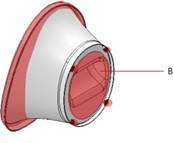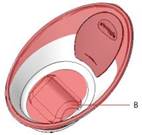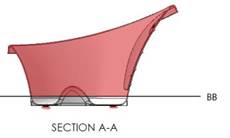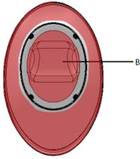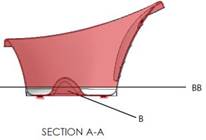Freely Available British and Irish Public Legal Information
[Home] [Databases] [World Law] [Multidatabase Search] [Help] [Feedback]
Intellectual Property Enterprise Court
You are here: BAILII >> Databases >> Intellectual Property Enterprise Court >> Shnuggle Ltd v Munchkin, Inc. & Anor [2019] EWHC 3149 (IPEC) (20 November 2019)
URL: http://www.bailii.org/ew/cases/EWHC/IPEC/2019/3149.html
Cite as: [2019] EWHC 3149 (IPEC)
[New search] [Help]
-->
BUSINESS AND PROPERTY COURTS OF ENGLAND AND WALES
INTELLECTUAL PROPERTY LIST (ChD)
INTELLECTUAL PROPERTY ENTERPRISE COURT
New Fetter Lane London |
||
B e f o r e :
sitting as a Judge of the High Court
____________________
| SHNUGGLE LIMITED |
Claimant |
|
| - and - |
||
| (1) MUNCHKIN, INC. (2) LINDAM LIMITED |
Defendants |
____________________
Ms Lindsay Lane QC (instructed by D Young & Co) for the Defendant
Hearing dates: 23 and 24 September 2019
____________________
Crown Copyright ©
Her
Honour Judge Melissa Clarke:
INTRODUCTION
1.
This case involves design
rights in baby baths. Baby bath design has become significantly more
sophisticated since I last purchased one about 13 years ago, which was little
more than an elongated bucket. They are now available in a myriad of sizes,
shapes and colours with numerous features such as collapsibility for storage,
detachable cups to pour water, integral drains etc. Of particular importance to
this case is the development of a common feature which appears to be
colloquially known in the field as a “bum bump”. This is a feature which is
intended to stop a slippery wet baby from sliding down the bath and underneath
the surface of the water. It is generally (but not always) a moulded ‘lift’ at
the bottom of the baby bath, so that the baby’s bottom sits in the space to the
rear of it and the baby’s legs sit over or around it, hence preventing
slippage. It has the added benefit of providing support to free the carer’s
hands to wash the baby.
2.
The Claimant (“Shnuggle”) is a small company based in
Northern Ireland, which designs, manufactures and sells baby products. The
First Defendant (“Munchkin”) is a
large company based in the US, which does the same. The Second Defendant (“Lindam”) is an indirect subsidiary of
Munchkin. It is based in the UK and distributes Munchkin’s products here. Mr
Michael Hicks appears for Shnuggle and Ms Lindsay Lane, Queen’s Counsel,
appears for Munchkin and Lindam.
Shnuggle
and the Shnuggle Mk1 and Shnuggle Mk 2 baths
3.
In 2012 and 2013 Shnuggle (through
its director and product designer Adam Murphy) designed and developed for
production a baby bath made from expanded polypropylene foam, which it first
sold on the market in January 2014. It sold about 700 units in total: half in
the UK and half to retailers in Spain and Poland. I will refer to this baby
bath as the Shnuggle Mk 1.
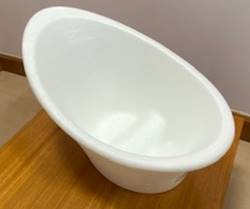

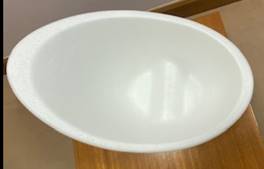
Fig 1a, 1b, and 1c: Shnuggle Mk 1
4.
Shnuggle was not satisfied
with the production quality of Shnuggle Mk 1 and so it developed that design
further between August and December 2014, producing a version made from
thinner, injection moulded polypropylene. This first sold on the market in the
UK in early 2015. I will refer to this baby bath as the Shnuggle Mk 2.
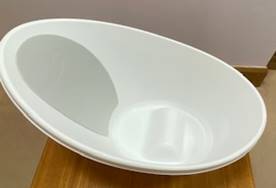
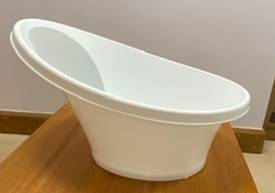
Fig 2a, 2b: Shnuggle Mk 2
5.
The Shnuggle Mk 2 has
achieved significant commercial success in the UK, Europe, North America, Asia
and Australia, selling online and through major retailers. These include, in
the UK, John Lewis, Argos, Mothercare and Mamas and Papas.
6.
Shnuggle own two
registered Community designs with which this claim is concerned (the “RCDs”):
i)
No. 002224196-001 (“RCD-196”) filed on 20 April 2013 in
respect of the Shnuggle Mk 1 (see Annex
1 to this judgment);
ii)
No.
002616763-0001 (“RCD-763”) filed on
20 January 2015 in respect of the Shnuggle Mk2 (see Annex 2 to this judgment).
7.
Shnuggle also claims UK
unregistered design rights under section 213 of the Copyright Designs and Patents
Acts 1988 (“CDPA”) in respect of 6
designs (“UDRs”) which relate to certain
parts of the Shnuggle Mk 1 and Shnuggle Mk 2 baby baths (“Shnuggle Designs”). The Shnuggle Designs are identified in the
Particulars of Claim at paragraphs 12(1) to (6) and at Annex 5 thereto. Some
(but not all) views of the Shnuggle Designs have been set out, conveniently, in
a single table in the Claimant’s skeleton argument, and I reproduce that at Annex 3 to this judgment.
Munchkin
and the Sit & Soak bath
8.
Mr Quinn Biesinger, senior
product designer of Munchkin, designed a baby bath for Munchkin in October and
November 2017. This was first sold on the market in the UK in January 2019
under the name “Sit & Soak”. The Sit & Soak is sold online and through
retailers including Argos. Munchkin accepts: (i) that there is no evidence that
Mr Biesinger saw or had access to the Shnuggle Mk 1; and (ii) that Mr Biesinger
had a sample of the Shnuggle Mk 2, which was a point of reference and an
inspiration for the design of the Sit & Soak. Indeed, an internal email of
26 October 2017 briefing Mr Biesinger during the design process describes his
objective as “aiming for a Shnuggle
inspired design with some added Munchkin flair and features”. After a
meeting on 1 November 2017 in which Mr Biesinger had presented some designs, he
was instructed to “Head more toward
Shnuggle based on Amazon reviews”.
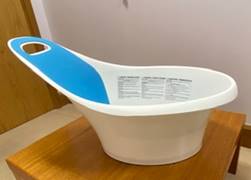
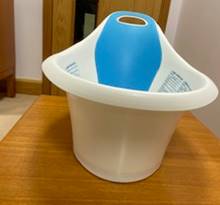
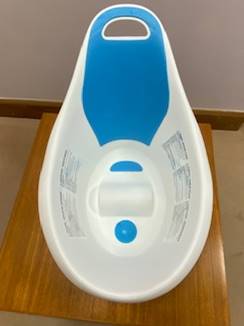
Fig 3a, 3b, 3c: Sit & Soak
9.
Fig. 4a, 4b and 4c below show
the Shnuggle Mk 1 (left), Shnuggle Mk 2 (centre) and Sit & Soak (right) side
by side from the top, side and underneath.
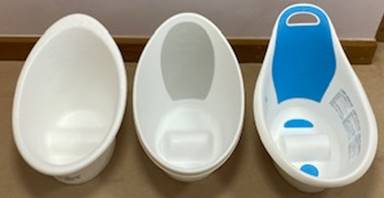
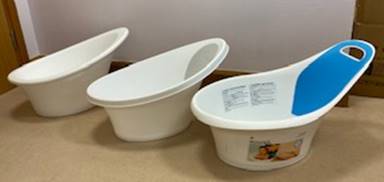
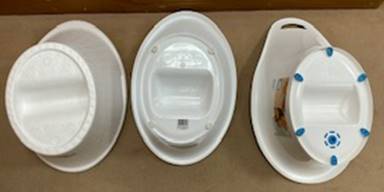
The parties’ cases
10.
Shnuggle claims that the
Sit & Soak infringes both the UDRs and the RCDs.
11.
In respect of the UDRs, Munchkin
and Lindam dispute subsistence of the rights, deny copying and deny infringement.
12.
Munchkin and Lindam rely
on the following pleaded prior art as commonplace designs:
i)
The Tippitoes mini bath (“Tippitoes”):

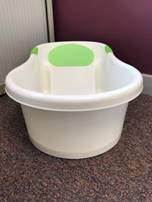
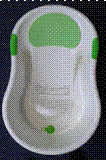
Figs. 5a, 5b and 5c: Tippitoes
ii)
The Mothercare slipper bath (“Mothercare slipper”):
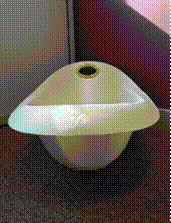
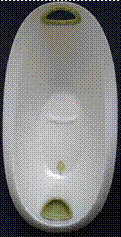
Figs 6a, 6b, 6c: Mothercare slipper
iii)
The Amalfi slipper bath (“Amalfi”), which is not a baby bath:
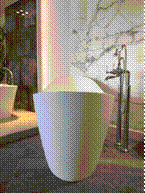
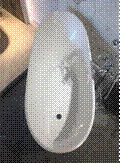
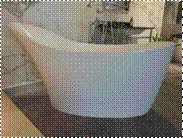
Figs. 7a, 7b, 7c: Amalfi
iv)
The Mebby Cocoon portable
baby bath (“Mebby Cocoon”):
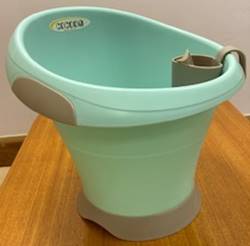
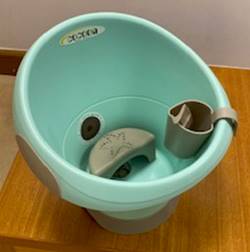
Figs. 8a, 8b, 8c
v)
The Shnuggle Mk 1 (see above).
13.
In respect of the RCDs,
Munchkin and Lindam deny infringement and by their counterclaim challenge their
validity on the basis of prior art. However this was narrowed at trial as the
challenge to the validity of RCD-196 was not pursued. Accordingly only the
validity of RCD-763 remains in issue.
14.
It is not disputed that if
the Sit & Soak bath infringes either the UDRs or the RCDs, Lindam is also
liable, as both Lindam and Munchkin accept joint responsibility for the sale of
the Sit & Soak in the UK.
THE ISSUES
15.
His Honour Judge Hacon
made a directions order on 26 March 2019 which limited the issues for
determination at trial. Those are reproduced below, amended slightly to reflect
the position at trial:
Registered Designs
i)
Whether [RCD-763 is] valid;
ii)
Whether the Sit & Soak
bath is an infringement of the RCDs;
Unregistered
Designs
iii)
Whether design right is
capable of subsisting in the Shnuggle Designs as being designs for the whole or
part of an article;
iv)
Whether the Shnuggle Designs
are original;
v)
Whether the Shnuggle
Designs are commonplace;
vi)
Whether the Sit & Soak
is an article which has been made by copying the Shnuggle Designs;
vii)
Whether the Sit & Soak
is an article which has been made to produce articles exactly or substantially
to each of the Shnuggle Designs.
The
Evidence
16.
As is usual in IPEC, HHJ
Hacon directed that the statements of case stand as the evidence in chief. He
further directed that the parties be permitted witness statements of fact in
respect of issue 1 (validity of the RCDs), 4 (originality), 5 (commonplace) and
6 (copying).
17.
He directed expert
evidence, including from Mr Murphy as an in-house expert, on issue 1 (validity
of the RCDs), issue 2 (infringement of the RCDs), issue 5 (commonplace), issue
6 (copying) and issue 7 (exactly or substantially), with the evidence on issues
1, 2 and 7 being limited to comparative drawings and explanations.
18.
In addition, the parties
have prepared a chart in the form recommended as useful by HHJ Hacon in Action Storage Systems Limited v G-Force
Europe.com Limited [2016] EWHC 3151 to assist the court in considering
individual features of the designs.
19.
Shnuggle relies on a
single witness: Mr Adam Murphy as both a witness of fact and an expert witness.
He filed a witness statement dated 14 June 2019 and an expert report dated 2
August 2019 and was cross-examined and re-examined.
20.
Munchkin and Lindam rely
on the following witnesses:
i)
Mr Quinn Biesinger, the
lead designer of the Sit & Soak, as a witness of fact. He filed a witness
statement dated 13 June 2019 upon which he was cross-examined and re-examined.
ii)
Mr Nicholas Trumbo as a
witness of fact. He filed a witness statement dated 13 June 2019 which, subject
to some agreed redactions, is not disputed. Accordingly he did not attend
trial.
iii)
Mr Michael Corcoran,
industrial designer, as an expert witness for the Defendants. He filed a report
dated 2 August
2019 and was cross-examined and
re-examined.
21.
I found Mr Murphy and Mr Biesinger
to be good, straightforward witnesses of fact. I am satisfied that each of them
endeavoured to assist the court with truthful evidence to the best of their
ability, recollection and belief. Mr Murphy did, as Ms Lane submits, have a
difficult job in being both witness of fact and expert but I consider that he
did so carefully and avoided too much elision of those roles, although
inevitably there was some. Ms Lane in particular says that there were concessions
he should have made as an expert which he did not make, probably because of the
close identification he had with the Shnuggle baths as their designer. I accept
that, but they were few.
22.
I found Mr Corcoran to be
a good expert of assistance to the court.
23.
I will consider the claims
in respect of the RCDs first before moving onto the UDRs.
THE
REGISTERED DESIGN CLAIMS
Legislation
24.
Council Regulation 6/2002/EC of 12 December 2001 on
Community designs (“the Regulation”)
applies. The relevant Articles include the following:
“Article 4
Requirements
for Protection
1. A design shall be protected by a Community design
to the extent that it is new and has individual character.
…
Article 5
Novelty
1. A design shall be considered to be new if no
identical design has been made available to the public:
...
(b) in the case of a registered Community design,
before the date of filing of the application for registration of the design for
which protection is claimed, or, if priority is claimed, the date of priority.
2. Designs shall be deemed to be identical if their
features differ only in immaterial details.
Article 6
Individual
character
1. A design shall be considered to have individual
character if the overall impression it produces on the informed user differs
from the overall impression produced on such a user by any design which has
been made available to the public:
...
(b) in the case of a registered Community design,
before the date of filing the application for registration or, if a priority is
claimed, the date of priority.
2. In assessing individual character, the degree of
freedom of the designer in developing the design shall be taken into
consideration.
Article 10
Scope of
Protection
1. The scope of the protection conferred by a
Community design shall include any design which does not produce on the
informed user a different overall impression.
2. In assessing the scope of protection, the degree of
freedom of the designer in developing his design shall be taken into
consideration.”
25.
Jacob LJ in Dyson Ltd v Vax Ltd [2012] FSR 4 at [8]
and [9], emphasising a passage from his judgment in Procter & Gamble v Reckitt Benckiser [2008] ECDR 3 at [3] and
[4] said “The most important things are
the registered design, the accused object and the prior art, and the most
important thing about each of these is what they look like”. The Supreme
Court in Magmatic approved this pithy
summary of registered design law.
Discussion
of legal principles
New
26.
‘Immaterial details’ means
‘only minor and trivial in nature, not affecting overall appearance’. This is
an objective test. The design must be considered as a whole. It will be new if
some part of it differs from any earlier design in some material respect, even
if some or all of the design features, if considered individually, would not
be.
Individual
Character
27.
Recital 14 to the
Regulation provides some guidance on the meaning of ‘individual character’:
“The assessment as to whether a design has individual
character should be based on whether the overall impression produced on an
informed user viewing the design clearly differs from that produced on him by
the existing design corpus, taking into consideration the nature of the product
to which the design is applied or in which it is incorporated, and in
particular the industrial sector to which it belongs and the degree of freedom
of the designer in developing the design.”
28.
Designs within the
existing design corpus must be considered individually, and not by combining
features of some designs with those of others.
Informed
User
29.
What is the nature of the
informed user? He or she is notional and a construct. The Court of Appeal
approved the description of HHJ Birss QC (as he then was) sitting as a High
Court Judge at [33] and [34] of Samsung
Electronics (UK) Ltd v Apple Inc. [2012] EWHC 1882 (Pat), [2013] ECDR 1 in
the appeal from that judgment Samsung
Electronics (UK) Ltd v Apple Inc. [2012] EWCA Civ 1339, [2013] FSR 9:
“[33] The designs are assessed from
the perspective of the informed user. The identity and attributes of the
informed user have been discussed by the Court of Justice of the European Union
in PepsiCo v Grupo Promer (C-281/10P)
[2012] RSR 5 at paragraphs 53 to 59 and also in Grupo Promer v OHIM [2010] ECDR 7, (in the General Court from which
PepsiCo was an appeal) and in Shenzen Taiden v OHIM, case T-153/08, 22
June 2010, BAILII: [2010] EUECJ T-153/08.
[34] Samsung submitted that the
following summary characterises the informed user. I accept it and have added
cross-references to the cases mentioned:
He (or she) is a user of the product in
which the design is intended to be incorporated, not a designer, technical
expert, manufacturer or seller (PepsiCo paragraph
54 referring to Grupo Promer
paragraph 62);
However, unlike the average consumer of
trade mark law, he is particularly observant (PepsiCo paragraph 53);
He has knowledge of the design corpus and
of the design features normally included in the designs existing in the sector
concerned (PepsiCo paragraph 59 and
also paragraph 54 referring to Grupo
Promer paragraph 62);
He is interested in the products concerned
and shows a relatively high degree of attention when he uses them (PepsiCo paragraph 59);
He conducts a direct comparison of the
designs in issue unless there are specific circumstances or the devices have
certain characteristics which make it impractical or uncommon to do so (PepsiCo paragraph 55).
[35]
I would add that the informed user neither (a) merely perceives the designs as
a whole and does not analyse details, nor (b) observes in detail minimal differences
which may exist (PepsiCo paragraph
59).”
Technical function
exception
30.
Registered design
protection will not subsist in ‘features of appearance of a product which are
solely dictated by its technical function’ (Article 8(1) of the Regulation).
31.
If all of the features of
appearance of the product are solely dictated by its technical function, then
the registration will be invalid (per the UK Board of Appeal decision in Lindner Recyclingtech
v Franssons Verkstader
[2010] ECDR 1) which is not binding upon, but which has been approved by, English
courts: see Arnold J in Dyson v Vax,
approved by the Court of Appeal on appeal and Birss J in Sealed Air v Sharp Interpack. This is not such a case. However, where
only one or more features of appearance of a product are solely dictated by its
technical function, but others are not, considerations arise about scope of
protection and the design freedom of the designer.
Degree
of Design Freedom
32.
The court must take the degree
of freedom of the designer in developing the design into consideration both in
assessing ‘individual character’ (Article 6(2) of the Regulation) and in
assessing the scope of protection (Article 10 of the Regulation). It is
important because similarities between products which are attributable to
design constraints will be given little significance in the comparison of the
overall impressions they produce. Where there is a high level of design
freedom, attention is likely to be focussed on those parts where there is a
greater potential for variability.
33.
His Honour Judge Hacon sitting
as a Judge of the High Court in Cantel
Medical (UK) Ltd v ARC Medical Design Ltd [2018] EWHC 345 (Pat) discussed
the designer’s degree of design freedom, setting out the key points to
consider:
i)
The constraints imposed by
the technical function of the product or the statutory requirements;
ii)
Similarities between the
designs of corresponding parts of two products which are attributable to design
constraints will be given little significance in the comparison of the overall
impressions they produce;
iii)
Where there are at least
some elements in respect of which the designer had a high level of design
freedom, attention is likely to be focused on those parts with their greater
potential for variability. Similarities cannot be explained away be design
restraints and will tend towards the view that overall impressions do not
differ, whereas differences will lead towards the opposite conclusion;
iv)
Finally, when comparing
the design in question to the design corpus, HHJ Hacon in Cantel explains at [169] that:
a)
A design which is markedly
different will confer a greater scope of protection;
b)
Little or no weight should
be given to common features.
Design Representation
34.
An issue in this case is
the impact of the colour and contrast shown on a registered design to the scope
of protection. That is because when a registered design comes before the court
which is to determine the scope of protection, the question is a matter of the
proper interpretation of the relevant registration, and the images included in
that representation.
35.
In PMS International Group Plc v Magmatic Limited [2016] UKSC 12, Lord
Neuberger (with whom all others agreed) said at [32]:
“It is for an
applicant to make clear what is included and what is excluded in a registered
design and he has wide freedom as to the means he uses. It is not the task of
the court to advise the applicant how it is to be done.”
36.
He further quoted with
approval from the writings of Dr Martin Schlotelburg, of the EUIPO design
department:
“…the
selection of the means for representing a design is equivalent to the drafting
of the claims in a patent: including features means claiming them.”
37.
In summary, it is up to
the applicant for a registered design right to decide what to apply for (e.g.
the design for the whole article or just part, and if so what part(s)), what
features to include in the design application and what to leave out, and how to
represent them. As Munchkin submits, and as I accept, per Magmatic on appeal, where a design is registered in colour and/or
contrast, then that must be taken into account when considering infringement,
and the use of colour and/or contrast will serve to limit the scope of the
registered design.
Assessment
38.
I will deal with whether
the Sit & Soak infringes RCD-196 before going on to consider whether
RCD-763 is valid and, if so, whether the Sit & Soak infringes it.
Who
is the informed user?
39.
I consider that the market/industrial
sector is the general market for baby baths, rather than a wider market for
baths generally (which would include adult or specialist baths). It is common
ground that the informed user is an interested and observant adult user of baby
baths who may be a parent, carer, or relative of the baby who is to use it. He
has the characteristics identified by HHJ Birss in Samsung v Apple set out above.
What
is the design corpus?
40.
It is common ground that
there is a wide and varied design corpus in the general market for baby baths
of which the informed user would be aware, and I have been provided with
physical examples of many of them. They include the Tippitoes, Mothercare
slipper, Mebby Cocoon and Shnuggle Mk 1 which are part of the prior art I have
identified for the UDR claim, but also a great number of others, including: a
“traditional” Mothercare bath; the Tummy Tub; the Boon Naked which is a
collapsible bath; the Boon Soak; the Nuby which is almost identical to the
Tippitoes; and the John Lewis Value bath which is another ‘slipper’ type bath
similar to the Mothercare, with a higher back than front, albeit the latter has
a more modern aesthetic.
Is
the RCD-196 new and does it have individual character?
41.
It is Shnuggle’s case that
the RCD-196 is a significant design departure from existing baby baths, which
were either of a more traditional type requiring the baby to recline back
considerably while being bathed, or of ‘bucket’ type baby baths like the Tummy
Tub and Mebby Cocoon. Munchkin accepts that there is no evidence in the design
corpus of any identical design which had been made available to the public in
the UK at the time the RCD-196 was designed, and nor is there any baby bath
whose features differ only in immaterial details.
42.
Munchkin submits that
RCD-196 is an intermediate type bath, suitable for older babies than newborns,
which allows them both to be supported in a more upright position at 3-5 months
or so, and also to sit by themselves from 5 or 6 months old. Mr Murphy accepted
all of those points in cross-examination. However Munchkin submits that the
Tippitoes is a similar intermediate-type bath with similar features, and of
similar size to the Shnuggle Mk1. It points to an email written by Mr Murphy to
his wife while he was designing the Shnuggle Mk1 attaching a screenshot of the
Tippitoes and entitled “A similar
bath!!!” I accept that there are similarities in what the Tippitoes is
trying to achieve in terms of aiming at a similar age-range of baby, producing
support in the form of an angled back in a more upright position and with a bum
bump. However design right does not protect ideas. The way in which the
Tippitoes and the RCD-196 achieve those aims is visually extremely different in
my judgment, giving rise to a significantly different design.
43.
I am satisfied that
RCD-196 is new and has individual character.
What
are the technical constraints and the degree of freedom of the designer?
44.
I must consider what
features of the design of a baby bath are solely dictated by technical constraints
or other design constraints . In doing so I am
considering designs for the industrial sector I have identified, i.e. the
general baby bath market. Accordingly the design constraints include
constraints of volume manufacture and sale. I am not concerned with
hand-hammered, bespoke copper baby baths, which is a different market.
45.
Shnuggle submits that the
only real technical constraints on the designer of a baby bath are that the
bath must hold water and be sufficiently large to take a baby. I accept those
are two constraints, but I do not accept those are the only ones.
46.
Munchkin submits that the
designer of a baby bath is subject to a number of design constraints which
limit the scope of protection, and which I set out below with my comments:
i)
The baby
will be within a range of proportions (depending on its age). I agree that it is a design
constraint that a baby bath must fit babies of different sizes and shapes
within the age range that it is designed for, and that a baby’s size will
increase over the time during which the baby bath will likely be used;
ii)
The baby will not (at least
initially) be able to support itself or its head and limbs. This seems to me to relate to the
baby and is not a constraint on the design of the bath. Although I accept that
a younger baby will require some support when using a baby bath, that support
could be provided entirely by the baby’s carer, as is the case when one bathes
a baby in a sink. Any requirement for the baby bath itself to provide partial
or full support may be a design objective, but in my judgment it is not a
design constraint.
iii)
The baby bath needs to be small
enough to fit in a sink. I
do not accept that as a design constraint, although it may be a design
objective. There are many volume-manufactured baby baths which do not fit into
a sink. In addition it raises further questions about the size and shape of the
sink it must fit in, sinks also being subject to very wide variation (as
accepted by Mr Corcoran in cross-examination);
iv)
The baby bath needs to be light
enough to be portable.
I accept that as a design constraint;
v)
The baby bath needs to be stable
with the water and baby in.
I accept that as a design constraint as a matter of both safety and
practicality;
vi)
There needs to be enough space to
wash the baby. I
accept that as a design constraint;
vii)
The baby bath needs to be suitable
for volume manufacturing at a relatively low price point. I agree it needs to be suitable for
volume manufacturing and sale but this relates to the sector, and is not a
design constraint. I do not know what “relatively low” means in this context.
Relative to what? I accept there is a range of acceptable prices, as did the
experts in cross-examination. In fact nothing turns on it; and
viii)
The baby bath needs to be capable of
being easily stacked during transport, storage and retail. I accept this is a design
constraint related to the sector, which is general baby baths for volume
manufacturing and sale.
47.
Despite
these constraints, I am satisfied there is still a large degree of design
freedom in the size (within a range), shape and overall appearance of a baby
bath. This can be seen in the surprisingly wide range of baby bath designs contained
in the design corpus.
What
features are common in the design corpus?
48.
Munchkin submits that the
following features, identified by Mr Corcoran, are common in the design corpus:
i)
slipper
baby baths (where the back is higher than the front) (see Mothercare slipper,
John Lewis value);
ii)
having
the back at an angle to support the baby’s head;
iii)
a
bum bump;
iv)
a
pad at the baby’s head or back for comfort;
v)
a
base and sides;
vi)
narrower
sides and a wider top; and
vii)
a
skirt or flange around the base.
49.
Mr Murphy accepted these
as common in cross-examination. Miss Lane also suggested, and he accepted, that
an ellipse or oval shape for the base and top was common. I accept all of these,
and that little or no weight should be given to common features. She further suggested that a concave exterior
curve from the higher at the top to lower at the bottom of the bath was common
and he accepted it existed in the design corpus, but I don’t consider, looking
at the design corpus, that it is common. I can see it in the Mebby Cocoon,
which itself is a relatively unusual bath, but the vast majority of the design
corpus have a convex exterior curve or are straight-sided. I do not find that
to be common.
Scope of design
ascertainable from the registration
50.
The scope of design
ascertainable from the registration is viewed through the eyes of the informed
user. How would he interpret the registration, which in this case is a series
of CAD renderings without commentary? In particular, what is the significance
of the colour of the renderings?
51.
Shnuggle submits that the
colour of RCD-196 would be interpreted by the informed user to be off-white in
colour, or perhaps a bluey-grey (but in any event monochrome), and he or she would
interpret the colour in the rendered drawings as having no purpose save to
indicate, in the tonal differences of the rendering, the shape of the design. Accordingly
Shnuggle submits that the scope of design should not be limited to the colour
blue and it is for shape only.
52.
I accept Munchkin’s
submission that as a matter of fact, RCD-196 is registered in blue, whether
that was Shnuggle’s intention or not. I cannot accept that the informed user
would perceive the renderings either as off-white, or as a bluey-grey monotone
intended to be any colour or none. Mr Murphy very fairly accepted in
cross-examination that they were blue. If Shnuggle had wanted to register only
the shape of the bath, instead of positively choosing the colour blue, it could
have provided a line drawing (as it did for RCD-763) or rendered it in
monochrome shades of grey. In my judgment that colour choice limits the scope
of protection, per Magmatic.
What
overall impression does the design, prior art and accused product give?
53.
Munchkin submits that the
most notable features of the RCD-196 when compared to the prior art are:
i)
the
perfect oval shape formed by the top and back of the bath;
ii)
the
prominent flat rim;
iii)
the
handles on the middle of the sides;
iv)
the
absence of a back pad;
v)
the
colour blue; and
vi)
the particular shape of the bump.
I agree with
that list, save that I consider the fact that the bum bump is a hump which goes
from side to side at the base of the bath is notable by the informed user,
rather than any specific dimensions or cross-section of it. I would also add
that I consider the way in which the body of the bath flares out from the oval
base to the oval top to be a notable feature. None of these, save the last
which I have added, are present in the Sit & Soak.
54.
Shnuggle submits that the
similarities between the RCD-196 and the Sit & Soak include:
i)
The generally oval cross-sections,
and the proportions of the ovals in RCD-196 (i.e. length and width) are very
similar. I do not
consider that the informed user will be assessing the similarity of the two
designs by reference to cross-sections or measurements, although I accept that
he or she will notice whether proportions are similar or dissimilar. I consider
that the informed user will consider that the Sit & Soak is of generally
similar proportions, but with an elongated back.
ii)
All the horizontal cross-sections
are oval. I accept
that the informed user will note the oval base, the oval pedestal and the
generally oval tops of RCD-196 and the Sit & Soak but again I do not
consider he or she will perceive them in terms of cross-sections.
iii)
The very similar ‘bum bump’ in terms
of both height and position. I
accept the height and position are similar but I consider the informed user
will perceive the shape of the bum bumps as differences.
iv)
The way in
which the upper edge of the baths start relatively horizontally and then curve
upwards, leading to a higher back than front. This is a description of a slipper bath which I have
found to be common.
v)
The similar rolled edge effect. I disagree. RCD-196 does not have a
rolled edge but a flat solid rim.
55.
Munchkin
submits that the differences are:
i)
RCD-196 is thick walled, whereas the
Sit & Soak is thin walled. That means that the rolled edge effect, while
similar, is created differently.
I disagree. I accept Shnuggle’s submission that the thickness of the walls of
RCD-196 are not easy to perceive from the design, and certainly not in the way
that it is easy to perceive in the Shnuggle Mk1. Accordingly I do not consider
that the informed user would perceive this as a significant difference,
although they might extrapolate from the thick edge that there is some
difference in thickness.
ii)
The Sit & Soak is slightly
longer (4.8% at the bottom, 7.2% at the top). I consider that the informed user has no reason to
measure these baths and will perceive them as very similar in proportions at
the bottom, but will perceive that the Sit & Soak is longer at the top
because of the elongated back in which the handle is placed.
iii)
The Sit & Soak ‘bum bump’ is
slightly different at the corners, but the cross-section is almost identical. I do not consider that the informed
user will be assessing what the two bumps might look like in cross-section. As
I have already indicated, I think the informed user will perceive that the bump
is similar in terms of placement and height, but will consider the shape of the
bump to be quite different.
iv)
The back of the Sit & Soak extends
upwards more than in RCD-196. I
agree.
v)
While the upper edge curves upwards
in both when viewed from the side, the Sit & Soak curve is slightly
different. I
consider the informed user will perceive Sit & Soak to be quite different
in this aspect.
vi)
The Sit & Soak has a padded back
that has been stuck on after manufacture of the main bath. I agree that the padded back is a
difference but I do not know that the informed user will perceive how it has
been manufactured.
vii)
The base of the Sit & Soak has a
flange and the underside is consequently different. I do not consider that the informed
user will pay very much attention to the flange or the underside, save for the
feet.
viii)
The Sit & Soak has a plug. I am satisfied that the informed
user will perceive this difference.
Discussion and decision
56.
In my judgment the main visual
similarities between the RCD-196 and the Sit & Soak are around the shape
and proportions of the body or pedestal of both, and in particular the profile
of the body of the baths as they rise and flare out from base, below the rim. The shape and size of the body of
the bath are subject to some design constraints, but that elegant externally
concave rise from an oval base which the RCD-196 and Sit & Soak share is
not seen elsewhere in the design corpus before the RCD-196. The closest is the
Mebby Cocoon which has a rounder base, smaller proportions and does not flare
out to the same extent, although it does display external concavity. I agree
that the higher back than the front in both the RCD-196 and Sit & Soak is
visually similar, but I consider that this is common in the slipper-type baths
in the design corpus.
57.
The
main differences that I consider would be identified by the informed user, are
the following:
i)
The
Sit & Soak does not show the perfect oval shape of the top of the RCD-196.
Rather, it has been pulled out and extended at the back in a sort of teardrop
shape, so that the overall shape of the bath is like a Chinese soup-spoon,
rather than the purer flared-oval shape of the RCD-196. I consider that the
informed user would give this significant weight as it produces a significantly
different visual impression, and the shape of the top of the Sit & Soak is
not seen in the design corpus.
ii)
The
thin, floating edge of the Sit & Soak, which is pulled out from the sides
and front of the bath but not the rear elongated back/handle, is quite
different to the thick, seemingly solid rim around the whole of the top of RCD-196.
Again, I consider that the informed user would give this significant weight as
the visual impression that each create is quite different – airy and floating
in the Sit & Soak and solid in the RCD-196.
iii)
The
treatment of the handles. RCD-196 has small, quite unobtrusive handles at the
side under the thick rim, whereas the Sit & Soak has no handles at the
sides but instead a hole punched in the elongated back to serve as a handle.
Again, I consider that the informed user would give this significant weight as
the back and hole together produces a significantly different visual
impression, both as a handle but also as a semi-circular hole. I consider that
the informed user, when considering this hole, will understand this hole has
practical utility as a means of storing the bath on a hook.
iv)
The
back pad. RCD-196 has no back pad, whereas the Sit & Soak has a back pad
which is a distinctive shape and extends the full length of the back and around
the handle/hole. Although I have found
that a comfort pad at the back or head is a common feature, there is some
design freedom in placement, size, and shape of that pad and the choices made
in the distinctive Sit & Soak back pad are not seen in the design corpus
and provide a noticeable visual impression. Accordingly I consider that the
informed user will give this significant weight.
v)
Presence
of a drain in the Sit & Soak in a bold contrast colour. There is none in
RCD-196 and this will be perceived as a significant visual difference.
vi)
Bum
bump. This is an “island” type of bump in the Sit & Soak and a hump from
wall to wall of RCD-196. I accept it is a point of difference as well as a
point of similarity. Although the fact of the ‘bum’ bump is similar, and it is
placed a similar distance from the back of the tub where the baby sits, in my
judgment the informed user will perceive and give some weight to the different
visual impressions given by the different shapes of the bump, because he will
note that the baby’s legs can rest either side of the Sit & Soak ‘island’,
which it cannot in the RCD-196. I do not place that weight very high, but it provides
some weight.
vii)
The
colour. I have found that RCD-196 is limited in scope to the colour blue. The
Sit & Soak is white with blue contrasts in the back pad, drain, feet and
small non-slip details on the base.
viii)
Other
differences include the flange around the base of the Sit & Soak and the
additional non-slip pad on the base of the Slip & Soak which do not appear
in RCD-196, but these are very minor differences. I consider the informed user will
notice the non-slip pad, but give it very little weight. I doubt he will notice
the flange at all.
ix)
I
do not consider that the informed user will give any material weight to the
differences of the underside of the base, (including the differences in the
construction of the flange) which are not visible in use, save that the
contrasting blue feet of the Slip & Soak are noticeable enough to perhaps
be noticed, particularly while the bath is overturned to be emptied or dried,
or hung up on the back of a door as the hole in the handle enables it to be.
58.
Of
course it is easier to perceive similarities and differences than to describe
them in words. What matters is the overall
visual impression arising from a side-by-side comparison of RCD-196 and the Sit
& Soak. In my judgment if the informed user stands
back and looks at the two together, directly comparing them with everything in
mind that I have mentioned including the prior art, the Sit & Soak will
produce a different overall visual impression in his or her mind. I would also
have reached this conclusion even if I had found that RCD-196 was not limited
in scope to the colour blue. The key reasons are in the Sit & Soak’s unusual
teardrop shape compared to RCD-196’s oval, the extended, lengthened back to
form a handle with a hole punched out of it, the distinctive shape and
contrasting colour of the back pad extending up into and to the top of the
handle, and the difference between the solid, flat, rim around the whole of the
RCD-196 and the delicate floating edge of the front and sides only of the Sit
& Soak.
59.
For those reasons I find
that the Sit & Soak does not infringe RCD-196
Validity of RCD-763
60.
It
is common ground that design corpus for RCD-763 includes the Shnuggle Mk1 and
RCD-196. Munchkin submits that RCD-763
is very similar to RCD-196 except:
i)
It
is not limited by colour, being a line drawing;
ii)
It
has no handles at the side
iii)
It
has a back pad
iv)
It
has a different ‘island’ shaped bump.
61.
I
have found that my decision in relation to RCD-196 would have been the same
even if it was not limited by colour, so that does not take us any further. I
accept those other differences exist. To those I add from Shnuggle’s
submissions: (v) RCD-763 has a flange and a consequently different underside of
the base from RCD-196, and (vi) that the rim, while visually similarly thick
from above, can be perceived to be a thinner rolled rather than solid edge.
62.
Mr
Hicks also submits for Shnuggle that another difference between RCD-196 and
RCD-763 is that the former is thick walled and the latter is thin-walled. I
accept that is a difference between the Shnuggle Mk1 and the RCD-763 but I
again find it difficult to perceive the thickness of the walls from the RCD-196
design when compared to the RCD-763 design.
63.
In
terms of whether a design is new, this is measured against identical designs which
have been made available to the public. I do not understand Miss Lane’s
submissions for Munchkin to be that the RCD-763 is identical to the Shnuggle Mk
1 save for features which differ only in immaterial details, so she sensibly
does not make the argument that RCD-763 is invalid as it is not new. Rather she
submits that each of the other differences identified above are trivial from
the perspective of the overall impression of the informed user, such that the
RCD-763 does not make an overall impression which differs from that produced by
RCD-196 or the Shnuggle Mk1 (both being prior disclosure), and so it is invalid
for lack of individual character.
64.
Mr
Hicks submits that the differences identified are all present in the Sit &
Soak and therefore amount to similarities rather than differences between the
Sit & Soak and RCD-763. Where I have rejected his primary case of
infringement of RCD-196, he submits that these differences are visually important,
and give individual character, so RCD-763 is valid over RCD-196. However he
goes onto accept that if RCD-763 is valid, it will have a relatively narrow
scope of protection because of the presence of RCD-196 and Shnuggle Mk 1 in the
design corpus. Nonetheless he submits that the Sit & Soak will produce a
very similar overall impression to the RCD-763 and accordingly I should find
that it is infringed.
65.
I
am with Munchkin. The handles at the side of the RCD-196 are extremely
unobtrusive and their absence in RCD-763 makes little difference to the visual
impression. The back pad is different, but it is also common both in fact and
in the manner of its execution, so the informed user will give it no weight.
The flange is common and of no interest to the informed user in my judgment. The
differences to the underside I consider that the informed user will accord no
weight. The rim is a rolled edge but the visual impression is of a similar flat
wide rim to that of RCD-196 around the entirety of the top of the bath. The
island shaped bump is slightly different to the RCD-196 in shape and placement
but I do not consider it to be different enough to give, together with the
absence of handles, a clearly different overall visual impression, particularly
including the level of design freedom that I have found is accorded to a baby
bath designer. Accordingly I find that RCD-763
is invalid for lack of individual character.
66.
If
I am wrong about that, and it does produce a sufficiently different overall
visual impression to RCD-196 to be valid, I consider that the Sit & Soak
nonetheless will give a different visual impression to the informed user to RCD-763,
for the same reasons I gave in respect of RCD-196, and so I would find it not
to infringe RCD-763.
THE UNREGISTERED DESIGN CLAIMS
Legislation
67.
Section 213 of the Copyright, Patents and Designs Act
1988 was amended by the Intellectual Property Act 2014. It provides, so far as
is relevant, as follows:
“(1) Design right is a property right which subsists
in accordance with this Part in an original design.
(2) In this Part ‘design’ means the design of the
shape or configuration (whether internal or external) of the whole or part of
an article.
(3) Design right does not subsist in—
(a) a method or principle of construction,
(b) features of shape or configuration of an article
which—
(i) enable the article to be connected to, or placed
in, around or against, another article so that either article may perform its
function, or
(ii) are dependent upon the appearance of another
article of which the article is intended by the designer to form an integral
part, or
(c) surface decoration.
(4) A design is not ‘original’ for the purposes of
this Part if it is commonplace in the design field at the time of its
creation.”
68.
Section
226(1) CDPA provides that a person who is entitled to unregistered design right
has the exclusive right to reproduce the design for commercial purposes by
making articles to that design or by making a document recording the design.
69.
Section
226(3) provides:
“Reproduction of a design by making articles to the design means copying the design so as to produce articles exactly or substantially to that design”.
Discussion
of legal principles
70.
There
are three controversial areas of law between the parties on the legal
principles:
i)
What
is a “part of an article” following the amendment to section 213(2) CDPA by
section 1(1) of the Intellectual Property Act 2014 (“IPA 2014”)?
ii)
Is
it necessary that a “part of an article” be separately created for the purposes
of section 213(2)?
iii) What copyright threshold should be applied in assessing originality?
What
is part of an article?
71.
Section
1(1) of the Intellectual Property Act 2014 removed three words from section
213(2) CDPA, which previously read:
“In this Part
‘design’ means the design of any aspect
of the shape or configuration (whether internal or external) of the whole
or part of an article” (my emphasis).
72.
Section
213 has been the subject of considerable judicial criticism since it was
introduced in the 1988 Act. In Dyson Ltd
v Qualtex (UK) Ltd [2006] EWCA Civ 166; [2006] RPC 31, Jacobs LJ (with
whom Lloyd LJ and Tuckey LJ agreed) said in respect of the unamended Section
213 at [14]:
“It has the merit of being short. It has no
other. Jonathan Parker J considerably
understated the position, when he said, “regrettably, the drafting of section
213 leaves much to be desired” (Mark
Wilkinson Furniture v Woodcraft Designs [1997] FSR 63 at p.27). It is not
just a question of drafting (though words and phrases such as “commonplace”
“dependent”, “aspect of shape or configuration of part of an article” and
“design field in question” are full of uncertainty in themselves and pose near
impossible factual questions). The problem is deeper: neither the language used
nor the context of the legislation give any clear idea what was intended. Time
and again one struggles but fails to ascertain a precise meaning, a meaning
which men of business can reasonably use to guide their conduct. The amount of
textbook writing and conjecture as to the meaning is a testament to its
obscurity. We just have to do the best we can, trying to arrive at “an
interpretation which the reasonable reader would give to the statute read
against its background” per Lord Hoffmann in R (Wilkinson) v IRC [2005] UKHL 30, [2006] 1 All ER 529 at [18].
The absence of any clear policy, as to where the line of compromise was
intended to run, means that brightline rules cannot
be deduced”.
73.
It
is Shnuggle’s case that that the Shnuggle Designs are each a design of “part of an article”. Munchkin pleads
that each of the Shnuggle Designs is a design of an “aspect of the shape or configuration… of the whole or part of an
article”, and not “part of an
article”, and so, following the amendment of section 213 to excise
‘aspects’, are unprotectable. Miss Lane goes further and submits for Munchkin
that there is no rationale or reason for Shnuggle to seek to exclude particular
aspects of the designs of the Shnuggle Mk1 and Shnuggle Mk2 in the Shnuggle
Designs, and so it can be inferred that the reason it seeks to do so is because
the Sit & Soak does not reproduce those features and because the Sit &
Soak does not substantially reproduce the overall designs for the whole of the
articles. Miss Lane argues that the purpose of the amendment to section 213(1)
was to prevent claimants from chopping products up into little pieces in order
to try and emphasise those pieces which are similar or the same in the designs
and ignore the bits which are different.
74.
I
do not accept this submission. It is specifically provided in section 213(2)
that the right can subsist in relation to the shape or configuration of the
whole or part of an article. As Lewison J put it at [27] of Virgin Atlantic Airways Ltd v Premium
Aircraft Interiors Group Ltd and Anor [2009] EWHC 26(Pat), “One of the real difficulties of section 213
is that the claimant may select a part of the article and claim design right
for that part only. The courts have recognised this possibility since early
days of design right”. He cites Ocular
Sciences Ltd v Aspect Vision Care Ltd [1997] RPC 289 and A. Fulton Co Ltd v Totes Isotoner
(UK) Ltd [2004] RPC 16.
75.
Laddie
J (as he then was) giving the judgment of the court in Ocular Sciences said at page 422:
“The proprietor can choose to assert design
right in the whole or any part of his product. If the right is said to reside
in the design of a teapot, this can mean that it resides in design of the whole
pot, or in a part such as the spout, the handle or the lid, or, indeed, in a
part of the lid. This means that the proprietor can trim his design right claim
to most closely match what he believes the defendant to have taken. The
defendant will not know in what the alleged monopoly resides until the letter
before action or, more usually, the service of the statement of claim”.
76.
Jacob
LJ refined this a bit in Fulton v Totes,
saying at [34]:
I do not
fully go along with Laddie J.’s suggestion that what the proprietor can do is
to “trim his design right claim”. It is not really a question of “trimming” –
it is just identifying the part of his overall design which he claims has been
taken exactly or substantially. And although Laddie J. was right in saying that
the defendant will not know in what the alleged
(my emphasis) monopoly resides until the letter before action or claim form,
that does not mean the defendant does not know where he stands before then. The
man who copies a part of an article exactly or substantially, will know what he
has taken. It is true that it will be for the designer to formulate his claim
properly in any proceedings, but the subsistence of his rights does not depend
on how he frames his claim”.
77.
Miss
Lane for the Defendants submits that these pre-amendment cases are of little
assistance to the interpretation of section 213(2) as amended, but I do not accept
this submission. These authorities provide useful guidance as to the meaning of
“part” of a design and I consider that they remain useful guidance.
78.
To
the extent that Miss Lane submits that the guidance in those authorities refers
only to an ‘aspect’ of a design, I also do not accept that is so. Fulton
v Totes was an appeal against a finding that a separate design right
subsisted in a “cut off” design, i.e. where part of the article was removed
from consideration and design right asserted in what remained. The appeal was
on the basis that it was a creation of an artificial new design right in the
guise of selecting part of the actual design. At [13] to [28] Jacobs LJ
dismissed this argument, stating that unregistered design right subsisted in
“any aspect of the shape and configuration of part of an article” (original emphasis), emphasising ‘part’ not
‘aspect’. That he was considering ‘part’ is also clear in [32] in which he
explained that the appellant’s argument overlooked, inter alia, the must fit must match exceptions in section 213(3),
which he described as:
“features
which, if present, will be parts of an article (e.g. the fitting bits of a new
design of electrical plug). Plainly it was thought that unless they were
excluded they would be covered by the word “part” in the definition of design.
And it is to be noted that …the must fit/must match exception is put in at the
stage of designing design right, not at the stage of providing exceptions to
infringement”.
Is
it necessary for a part of an article to be separately created?
79.
The
Defendants submit that the following principles can be discerned from the case
of Neptune (Europe) Limited v DeVol
Kitchens Limited [2017] EWHC 2172 (Pat):
i)
To
be a part, as opposed to an aspect, something should be created separately and
not simply be a disembodied feature of a whole.
ii)
A
combination of parts created separately may nevertheless amount to an aspect.
iii)
A
part can be identified by the exclusion of other parts created separately.
80.
In
Neptune, the late Henry Carr J
considered the effect of the deletion of the words “any aspect of” from section
213(2). The case was about designs for kitchen furniture, and an issue was
whether some features which formed part of the Neptune kitchen units (but were not
seen in the alleged infringing units) could be excluded from consideration of
the design alleged to be infringed. Those features included cock-beading and moulding
on the doors of Neptune’s units. One issue in the case was whether Neptune in
seeking to exclude those features was seeking to rely upon “parts” rather than
“aspects” of the designs. Henry Carr J determined the point as follows at [44]
(original emphasis):
“This raises
the subtle question of the difference between “parts” and “aspects” of a design. In my view, aspects of a design include
disembodied features which are merely recognisable or discernible, whereas
parts of a design are concrete parts, which can be identified as such.
Returning to the example of Laddie J in Ocular Sciences, aspects of the design of a teapot could include the
combination of the end portion of the spout and the top portion of the lid,
which are disembodied from each other and from the spout and lid. They are not
parts of the design.
In my
judgment, none of the features which Neptune seeks to exclude, nor the
remainder of the designs after such exclusion, are properly characterised as
aspects of the designs. For example, the cock-beading and moulding are concrete
parts of the designs, which are created separately and then applied to the
Chichester cabinets.
The position would be different if Neptune was seeking to rely upon the combination of key features as a design, but that is not its case. I accept Neptune’s argument that, since the statute permits designs for parts of articles, it makes no difference whether those parts are identified by their presence, or by the absence of excluded parts. In my judgment, Neptune is entitled to rely upon the entirety of the designs in question, without the features which it seeks to exclude.”
81.
In
reaching that conclusion, Henry Carr J considered a number of authorities
including Dyson v Qualtex and DKH Retail.
82.
In
Dyson v Qualtex Jacob LJ discussed
what was the threshold or limit of an ‘aspect’ of a design. He said at [22]:
“... UDR can subsist in the “design of any aspect of
the shape or configuration (whether internal or external) of the whole or part
of an article.” This is extremely wide—it means that a particular article may
and generally will embody a multitude of “designs”—as many “aspects” of the
whole or part of the article as can be. What was the point of defining “design”
in this way I do not know. The same approach is not adopted for ordinary
copyright where the work is treated as a whole. But even with this wide
definition, there is a limit: there must be an “aspect” of at least a part of
the article. What are the limits of that? I put it this way in A. Fulton Co Ltd v Totes Isotoner
(UK) Ltd [2004] R.P.C. 16; [2003] EWHCA [sic] Civ 1514 at [31]:
“The notion conveyed by ‘aspect’ in the composite phrase ... is ‘discernible’
or ‘recognisable’”.
83.
Of course, requiring an
aspect merely to be “discernible” or “recognisable” is a very low threshold
which is hardly a threshold at all. If something is neither discernible nor
recognisable it is difficult to see how one could even characterise it as a
design, let alone how one could copy an indiscernible or unrecognisable aspect,
or establish it had been copied. As Jacobs LJ himself accepted in Fulton v Totes at [23], a design right “…is limited to preventing copying and
copyists must know what they are copying”.
84.
This
perhaps is at the heart of the contradiction HHJ Hacon identified in DKH Retail Ltd v H Young Operations Ltd [2014] EWHC 4034 (IPEC), [2015] FSR 21 when considering the effect of the excision
of the words “any aspect of” from section 213(3) at [10] – [18]. HHJ Hacon asked how, if “any aspect
of” was a threshold which narrowed the definition of a claim per Dyson v Qualtex, the removal of those
words would not have the effect of widening the definition, or alternatively
and at the very least, have no effect. However he was satisfied that was not
the effect, as paragraph 10 of the Explanatory Notes to the Intellectual
Property Act 2014 makes explicit that the intention of Parliament in making
this change was to narrow the definition further:
“Subsection (1) limits the protection for trivial
features of designs, by making sure that protection does not extend to ‘any
aspect’ of the shape or configuration of the whole or part of an article. It is
expected that this will reduce the tendency to overstate the breadth of
unregistered design right and the uncertainty this creates, particularly in
relation to actions before courts.”
85.
He concluded that one possible interpretation of the
effect of the amendment is:
“that
it no longer permits a claim to unregistered design right to extend to designs
other than those specifically embodied in all or part of the claimant’s
article, i.e. no more UK unregistered design rights in abstract designs...”.
86.
In
reaching his conclusions in Neptune,
Henry Carr J endorsed HHJ Hacon’s view that an effect of the amendment was that
there were to be no more unregistered design rights in disembodied or abstract
designs.
87.
I
do not accept the Defendant’s submission that ‘part’ of an article must be
separately created, in order be protected under section 213, for the following
reasons:
88.
First,
I do not understand Henry Carr J to be using “a concrete part which can be identified as such” to mean that a
part is only a part if it is separately created, or a separate component;
rather I understand him to be explaining in use of the word “concrete” that a
part must be an actual part of the
article, or as HHJ Hacon put it in DKH
Retail, “specifically embodied in”
all or part of the article, and not merely abstract.
89.
Second,
there is nothing in the statute which suggests that separate creation is a
requirement and I accept Mr Hicks’ submission that it would lead to absurdities
if an identifiable part of one article (say, a handle on the lid of a teapot) was
a ‘part’ for the purposes of section 213(2) because it had been created
separately (and then applied to the lid), and the same identifiable part of an
otherwise identical article was not, because it was manufactured in one piece (with
the lid). I do not understand Henry Carr J to be saying that it is necessary
for a part to be created separately but rather that if, as in the facts of Neptune, part of an article is separately
created, that may assist the court in identifying it as a part.
90.
Third,
there is nothing in the pre-amendment authorities put before me which supports
the contention that a “part” of an article must be separately created, although
the need for a part to be identifiable is well established, see for example Ocular Sciences at [34]. Mr Hicks for
Shnuggle submits that such an interpretation is contrary to Fulton v Totes (CA) at [28] and [29] and Virgin Atlantic v Premium at [31]. I
accept that submission.
91.
It
seems to me that now that the words ‘any aspect of’ have been excised from
section 213(2) there is no longer any practical utility to considering the
question “What is the difference between a ‘part’ and an ‘aspect’ of an
article?”. The relevant question should now be only “Is this a design for ‘part’
of an article?” We are still in the situation identified by Jacob LJ of having
to do the best we can with section 213(2) to arrive at the interpretation which
the reasonable reader would give the statute, read against its background.
However we are in a better position than was Jacob LJ at the time of Dyson v Qualtex, because we no longer
have “an absence of any clear policy, as
to where the line of compromise was intended to run”; we have the paragraph
10 of the Explanatory Notes to the Intellectual Property Act 2014 which tells us that the changes to section
213(2) were intended to narrow the definition by excluding trivial features
from protection.
92.
Accordingly
I consider that a part of an article for section 213(2) is an actual, but not
abstract part which can be identified as such and which is not a trivial
feature. Whether or not it is a trivial feature is a matter of fact which will
need to be assessed in the context of the article as a whole.
What
is the correct test for originality?
93.
Section 213(1) CDPA protects “original designs”.
Subject to the question of whether a design is commonplace, Shnuggle submits that
originality is to be assessed in the same way as originality in the context of
copyright law under the old UK common law copyright test of labour, skill and
effort. Per Russell-Clarke & Howe on
Industrial Designs, 9th Ed. at [4-046] to [4-047]: “original means that the design has been
originated by the author, in the sense of not having been copied from a previous
design, and the author has expended sufficient skill or labour on its creation
that it can fairly be counted as original”. HHJ Hacon applied the old UK copyright test in
DKH Retail at [19], referencing Magmatic at first instance at [84].
94.
The Defendants submit that it is not correct to say
the old UK copyright test applies, and draw the court’s attention to (i) Arnold
J’s application of the new test from Infopaq
(work comprising the expression of the author’s own intellectual creation) in Whitby Specialist Vehicles Ltd v Yorkshire
Specialist Vehicles Ltd [2014] EWHC 4242, and (ii) HHJ Hacon more recently
acknowledging in Action Storage Systems
Ltd v G-Force Europe.com Ltd [2016] EWHC 3151 that it was arguable that the
Infopaq test applied [22], but
finding that it made no difference on the facts of that case. I add to those
submissions that it appears from the reference in paragraph [51] of Neptune to “the copying of ideas expressed in a design which… involved original
design skill and labour and/or are the expression of the intellectual creation
of their author” that there was no concern before Henry Carr J about which
test should be used, probably because it too did not matter in the
circumstances of that case. There are a number of authorities which have conflated
the tests or declined to specify which test was being used on the grounds that
it didn’t matter.
95.
Miss Lane for the Defendants submits that in Action Storage HHJ Hacon held that the
new test raised the hurdle. I don’t believe that is controversial. As Mr Hicks
acknowledged in closing, and as I find, it also does not make any difference in
this case, in my judgment, so I will decline to determine the point, and leave
it for a case where it does make a difference.
Submissions and Discussion
Designs for the shape or
configuration of any part of an article?
96.
The first question is whether the Shnuggle Designs are
designs pursuant to section 213(2) CDPA at all. Are they each a design of the
shape or configuration of any part of an article?
97.
Shnuggle Design (1) is a design for the external shape
of the sides of the Shnuggle Mk 1, below a line marked “AA”, which is a
horizontal line taken from the underside of the lowest point of the rim. A
similar line marked “AA” is used to delineate what is claimed of Shnuggle Mk 2
in Shnuggle Design (3) and (4). Miss Lane submits for Munchkin that the line
“AA” in both cases is arbitrary and therefore abstract, as is the horizontal
line “BB” used to delineate what is claimed of Shnuggle Mk 2 in Shnuggle Design
(5) and the oval marked around part of the base in Shnuggle Designs (4) and
(6).
98.
She further submits that in each case, what is left is
a disembodied feature or features, which falls foul of the principles set out
in Neptune and the combination of
parts excluded is entirely arbitrary and therefore amounts to an “aspect” of a
design not a “part, contrary to the legislation and the reasoning in Neptune. Finally, she submits that even
at a conceptual level it is difficult to identify any of the Shnuggle Designs
as amounting to a specific part of the bath, describing them as “plainly
completely abstract”.
99.
Mr Hicks for Shnuggle contends that the Shnuggle Designs are designs for
parts of an article which are concrete parts which can be identified as such.
He says they are not a combination of arbitrary parts, but each consist of
continuous parts of the relevant Shnuggle bath.
100.
I am satisfied that each of
the designs is for an actual not abstract part, or concrete part, of the
relevant bath. I do not think the arbitrariness or otherwise of a line
indicating what is excluded is what dictates whether a design is a concrete or
actual part on the one hand or abstract on the other. The issue is whether it
is an actual part of the article and whether it can be identified as such. The
pink colour is also virtual and arbitrary, but the colour and lines together identify clearly what is excluded
and what is not.
101.
I also do not agree that
what is left are disembodied features. As Mr Hicks submits, you could take
several Shnuggle Mk 2 baths and chop them up in accordance with the Shnuggle
Designs (2) to (6), disposing of the excluded parts. What you would be left
with in each case is a single embodied part of the bath in which design right
is claimed. As Henry Carr J says in Neptune,
it might be different if Shnuggle were claiming design right in the discarded
parts, but it is not. The fact that conceptually it may be difficult to name
what is left is not to the point, as long as it can be identified as a part and
it is more than a trivial feature.
102.
The question which remains,
then, is whether any of those embodied parts are merely trivial features. I am
satisfied they are not in relation to Shnuggle Designs (1) to (5). I hesitate
over Shnuggle Design (6) which is only the flange. I have heard from Mr Murphy
that it has several functions. On balance I do not think it is a trivial
feature.
Are the Shnuggle Designs original?
103.
It is no longer disputed by
Munchkin that the Shnuggle Design (1) is original. I remind myself that is for
the external shape of
the Shnuggle Mk 1 except what is coloured pink above the line “AA”. A dispute remains about
the originality of Shnuggle Designs (2)-(6).
104.
Part
of consideration of originality is in the exclusion of the commonplace designs
from counting as original, and thus restricting the generality of the features
in which the author of a design is entitled to claim design right. I will put
consideration of whether the Shnuggle Designs or any part of them are
‘commonplace’ to one side for the moment and return to it later.
105.
The dispute between the parties in this case, as it
was in Neptune, is whether a new
design right arises in a design for the whole or part of an article which was
produced by making changes to an earlier design. Henry Carr J addressed this at
[130] to [134] of Neptune. I set out
[132] – [134] below:
[132] DeVOL submits that,
whatever may be the position in copyright law, where a design is produced by
making changes to an existing design, the question arises whether a new design
right subsists in the new design, or only in those parts of the design that
have been changed; Ultraframe v Eurocell [2005]
R.P.C. 7 at [129]–[131]; Raft v Freestyle [2016] EWHC 1711 (IPEC) in which changes to an existing design which were “minor and localised” did not
give rise to “a new originality”
in the design as a whole.
[133] I accept DeVOL’s submission on this issue. UK
unregistered design right, in contrast to copyright, has a relatively short
duration. Protection lasts for a maximum of 15 years from the end of the
calendar year in which the design was first recorded in a design document or an
article was first made to the design, whichever occurred first. If articles
made to the design are put on sale within the first five years from the end of
that calendar year, then the design right lasts for only 10 years from the end
of the calendar year of first sale. During the last five years of the term of
design right licences of right are available. It is important to prevent
“evergreening” of such design rights, where small changes are allowed to
prolong the duration of the right beyond that fixed by the legislation. Where
changes are relatively minor, no new design right will arise in the design as a
whole.
[134] Applying this analysis to Design 12, the
modification from arched tops to straight tops in the glazing did not give rise
to any new design right in the design as a whole. It was necessary for Neptune
to rely upon the earlier design with arched tops, and the date of commencement
of protection was the year in which articles made in accordance with the
earlier design were first put on sale.”
106.
Munchkin
submits that Shnuggle Designs (2) to (6) are not original, because they are
based on the Shnuggle Mk2 which, in turn, is based significantly on Shnuggle
Mk1. Accordingly, its primary case is that Shnuggle Designs (2) to (6) are
invalid for want of originality, but in the alternative, if the court finds
some originality, it relies on a squeeze argument and submits that Shnuggle
Designs (2) to (6) are extremely limited in scope to what is original.
107.
I
have heard from Mr Murphy in relation to the creation of the Shnuggle Mk 1 and
the Shnuggle Mk 2. His evidence was straightforward and honestly given, in my
judgment, that he designed the Shnuggle Mk 2 using the CAD designs from
Shnuggle Mk1, and kept the same outer dimensions. In his witness statement he shows
a CAD overlay of both, which show a near-identical match in the external side
walls.
108.
Mr
Murphy then said he then made a number of changes. Some of those were changes which
arose because of the use of different materials – he moved from a thick polypropylene
foam for the Shnuggle Mk1 to a much thinner injection moulded plastic for the
Shnuggle Mk2. The difference in the rim can be said to come also from the
change in material, as can the move towards an ‘island’ type of bum bump.
However he said that also considered and changed the shape and proportions of
the bum bump to be more comfortable for the baby, making it higher and an asymmetrical
oval and changing it to angle away from the baby; he introduced the back pad; he
added the flange for additional stability now that the bath was no longer
thick-walled (which in his description, which I accept, required specific
consideration and design work); and the flange created pockets for holes in the
base into which feet could be inserted.
109.
Munchkin
makes the following submissions on whether the differences between each of the
Shnuggle Designs (2)-(6) on the one hand and RCD-196 and the Shnuggle Mk1 on
the other, are sufficient to confer originality on the Shnuggle Designs (2) –
(6):
i)
Shnuggle
Design (2) excludes the rim, back pad and feet. However the body of the bath is
not original as it is near- identical to the exterior of Shnuggle Design (1), so
the only changes which could confer originality are the revised bump and the flange;
ii)
Shnuggle
Design (3) excludes the top, back pad and feet, so again the only aspects which
could confer originality are the revised bump and flange;
iii)
Shnuggle
Design (4) excludes the top, back pad, bump and feet so all that is left to
confer originality is the flange;
iv)
Shnuggle
Design (5) excludes the body of the bath and the feet, so the only aspects
which could confer originality are the revised bump and flange;
v)
Shnuggle
Design (6) excludes most of the bath, the bump and the back pad, so as with
Design 4, only the flange is left to confer originality.
110.
Munchkin
submits that the revised bump and the flange is not sufficient to bestow
originality, particularly if the test is the author’s own intellectual creation.
Miss Lane submits that the whole purpose of the originality requirement is to
prevent evergreening. Munchkin submits that this case is directly comparable to
the Neptune case where there were
only minor changes to the top of the unit and that was not good enough to
create a whole new design as it was insufficiently original.
111.
Shnuggle
submits that the fact that Shnuggle Design (1) was created for the Shnuggle Mk1
and incorporated in the Shnuggle Mk2 does not mean that it lacks originality,
merely that the design right expires earlier than the other Shnuggle Designs
which are relied upon. It submits that there is no basis for suggesting that
any one of the Shnuggle Designs is a slavish copy of anything else, or that Mr
Murphy did not expend sufficient time, labour and skill in the creation of the
designs (his preferred copyright test) to make them “original” in the copyright
sense.
112.
I
will put consideration of copying to one side, as we have not got there yet.
113.
I
accept Mr Murphy’s evidence of the work he put into the creation of the changed
bump, base and flange. I accept that is sufficient to bestow originality on Shnuggle
Design (5) (which is for the flange only) and on Design (6) (which is for the
flange and base including bump only) because I consider that those Shnuggle
Designs are original, not based on Shnuggle Mk 1 to any meaningful extent, and
so are an expression of the intellectual creation of Mr Murphy. The question
remains whether those changes are sufficient to bestow originality on Designs
(2) to (4), which are to a significant extent based upon Shnuggle Mk 1 as they
incorporate the whole or part of the body from Shnuggle Mk 1.
114.
Per
Neptune, no new design right will
arise where changes to an existing design are made which are only minor and do
not give rise to a new originality in the whole. I consider that the addition
of the flange/base with screw holes alone is only a minor change and is
insufficient to confer originality on Shnuggle Design (4). The amendments to
the both flange/base and the shape of the bump together are, on balance and in
my judgment, applying Neptune, also
insufficient to confer originality upon Shnuggle Design (2) and (3).
115.
That
is sufficient to dispose of the claim that the Sit & Soak infringes
Shnuggle Designs (2) to (4), without going on to consider whether any of the
designs are commonplace in the prior art, or copied at all.
Commonplace
116.
Munchkin
submits that there are aspects of the Shnuggle Designs which are also commonplace.
Miss Lane reminds me that Laddie J explained in Ocular Science that the commonplace exclusion applies to “any design which is trite, trivial,
common-or-garden, hackneyed or of the type which would excite no peculiar
attention in those in the relevant art”. This analysis must be conducted by
reference to material “shown to be
current in the thinking of designers in the field at the time of creation of
the designs” per Jacob LJ in Lambretta
Clothing v Teddy Smith Ltd [2004] EWCA Civ 886, [2005] RPC 6 at [56].
117.
Henry
Carr J in Neptune provided the following guidance at [60]:
“[60] Following the amendment to s.213(2), it is more
difficult for the claimant to define the shape of a design at a higher level of
abstraction than its physical manifestation in the relevant article. As
explained by Arnold J in the Whitby
case at [45], this makes it harder for the claimant to
prove infringement, and also makes it harder for the defendant to prove that
the design is commonplace. Nonetheless, the commonplace exclusion remains a
useful cross-check on the breadth of a claim to infringement – the more
generalised the definition of the design relied upon, the more likely it is to
encompass designs which would “excite
no peculiar attention in those in the relevant art.””
118.
Munchkin
submits that the Shnuggle Designs, if not invalid for lack of originality,
contain commonplace elements which squeeze the scope of protection.
119.
What
is and is not commonplace involves different considerations for the UDRs than
for the RCDs. In registered designs, the court must consider the whole of the
design corpus through the eyes of the notional informed user of the product,
the design corpus in this case being general baby baths, not adult or
specialist baths. In unregistered designs the court is considering only the
specifically pleaded prior art to determine what would be considered to be
commonplace by the notional designer in the design field. Mr Corcoran describes
that as an industrial product designer with at least several years’ experience
who has previously worked with a broad portfolio of products. Mr Murphy would
fit well within that description, in fact. Mr Murphy is less clear on the
notional designer in his report, although he described him as a designer of
baby baths, but he did not object to Mr Corcoran’s characterisation when it was
put to him in cross-examination, and so I accept it. The relevant design field
should take into account the sort of designs with which a notional designer
would be familiar (Lambretta Clothing v
Teddy Smith) and both Mr Corcoran and Mr Murphy agreed this would include
adult baths as well as baby baths.
120.
There
is a helpful section on how the commonplace exception applies in practice in Russell-Clarke & Howe on Industrial Designs,
9th Ed. at
paragraph 4-050 which Ms Lane sets out in her skeleton argument (footnotes
excluded):
“In
considering what effect is to be given to the exclusion of protection of
“commonplace” designs, it should be born in mind that design right is capable
of subsisting not merely in the shape or configuration of a whole article but
also in any part of that article. It may be rare that the entire design of a
complete article with all its details can be said to be “commonplace” however,
unless an article is of a wholly new kind, or of a very rare kind, there will
almost always be parts of the design of an article which are commonplace, particularly
if its features are looked at at a high enough level
of generality. It can therefore be seen that the exclusion of “commonplace”
designs from counting as original has the effect of restricting the level of
generality of the features in which the author of a design is entitled to claim
design right. Thus, competitors may copy an article, provided they copy only at
such a general level that the features they have copied are commonplace.
However, design right may still subsist in the detailed implementation of
features which are commonplace at a general level:
“Nevertheless
while I accept that it could be said to be commonplace for a flat folding
umbrella to have a rughly rectangular handle, that
does not mean that the shape or configuration of any particular handle is
commonplace merely because it is roughly rectangular. Within the broad
parameters of size and shape which [the defendant] says are to be expected of
handles for flat folding umbrellas, there is considerable scope for detailed
design work to be undertaken, and for the creation of a shape or configuration
which has its own special qualities and which is not commonplace” [from A. Fulton v Totes]
In addition
to the case where the overall shape of an article is commonplace when
considered at a certain level of generality, there will be cases where small
details or embellishments or other features will be commonly used in the
industry. The effect of the exclusion of “commonplace” designs is that such
features may freely be copied, with the proviso that the particular way in
which commonplace details are deployed may be the subject of valid design right
and so protectable, and that a valid design right can clearly subsist in an
original and non-commonplace combination of features each of which viewed on
its own is commonplace.”
121.
Looking
at the Action Storage schedule
produced by the parties, Munchkin asserts that: (i) Shnuggle Design (1) is
commonplace and/or lacks individual character and relies on the Tippitoes and
the Amalfi; and (ii) both Shnuggle Design (5) and (6) are commonplace and/or
lack individual character, and relies on the Tippitoes, the Amalfi and the
Shnuggle Mk 1.
Shnuggle
Design (1)
122.
Shnuggle
Design (1) is that part of the design drawings set out in Annex 5 which are not
coloured pink, i.e. that part which is left below the line “AA”. This is a
portion of the sides of the ‘tub’ part of the baby bath, and the base.
123.
After
sending this judgment out in draft, Mr Hicks for Shnuggle provided further
written submissions to the effect that Shnuggle Design (1) only concerns the
shape of the sides of the Shnuggle Mk 1 and does not include its base. Mr Hicks
submits that can be discerned (i) from the drawings in Annex 5, which show only
the sides and not the base; (ii) from the fact that the pleadings do not show
or refer expressly to the base or underside as they do elsewhere where the base
or underside of a Shnuggle baby bath is relied upon; and (3) from the written
description accompanying the Shnuggle Design (1) drawings in Shnuggle’s Amended
Particulars of Claim and Action Storage Chart, which states “The external shape of sides the
Mk1 below the line marked “AA” on page 1 of Annex 5. Such external shape
includes the generally oval horizontal cross-sectional profile of the sides upwards
from the base to the plane “AA””.
In addition, Mr Hicks submits, Munchkin did not suggest at trial that it
avoided infringement of Shnuggle Design (1) because the base was included as
part of Shnuggle Design (1).
124.
Shnuggle
sent further written submissions in response which I have considered.
125.
I
do not accept Munchkin’s submissions for the following reasons:
i)
Annex 5 to the Particulars of Claim which
identifies the UDRs is reproduced in Annex 3 to this judgment. That states at
the very top, above the drawings of the various Shnuggle Designs, “In each case, what is claimed in the
relevant design is not coloured pink and what is excluded is coloured pink”.
All that is coloured pink in the two drawings which comprise Shnuggle Design (1)
is that portion of the bath which lies above the line marked “AA”. That is what
is excluded. The rest of the bath is not coloured pink, and this must be what
is left is claimed in the design. If the intention was to exclude the base, it
should have been pictured and coloured pink, as it is in Shnuggle Design (4)
and Shnuggle Design (6). It is Annex 5 to the Particulars of Claim which
defines what unregistered design rights are being claimed by Shnuggle.
ii)
The
accompanying narrative may be the source of the ambiguity now alleged by Mr
Hicks for Shnuggle. The first part of it: “The external
shape of sides the Mk1 below the line marked “AA” on page 1 of Annex 5” I understood to be a descriptor of what the drawings
showed, in particular (as Mr Hicks emphasized in oral argument at trial) that
it was the external sides of the
Shnuggle Mk 1 which were claimed, and not the full thickness of the walls of
that bath. To my mind, no doubt informed by the drawings and by the wording
which follows, the external sides below the line marked “AA” encompass the
underside. The wording which follows is
“Such external shape includes the
generally oval horizontal cross-sectional profile of the sides upwards from the base to the plane
“AA””. If, as Mr Hicks now suggests, only the external sides and not the
underside is covered by the shape of the design, why is it describes as being
included within the external shape? That implies that there is something else
covered by the design. In particular, that wording suggests to me, and I
understood it to mean, that the shape of Shnuggle Design (1) was for the entire
of the exterior sides of the bath below Line “AA”, including the sides rising
upwards from the base, but also including the underside.
iii)
In
addition, at paragraph 72 of the Claimant’s skeleton argument, which I have
referred to extensively in preparing my judgment, Shnuggle Design (1) is shown
next to wireframe drawings of the Sit & Soak and Shnuggle Design
superimposed upon each other, and those include both the base and the bump of
each.
iv)
Ms
Lane’s skeleton argument for trial (repeated in her closing note) refers at
paragraph 63(1) to “Design 1 – simply has
an arbitrary horizontal line AA drawn across the Mark 1 near the top in order
to exclude everything above it” and she made a specific submission at
paragraph 103 that “the person interested
in baby baths would not consider that the base of the Sit & Soak was made
substantially to Design 1”.
v)
I
also understood that to be Ms Lane’s understanding by her oral submissions about
Shnuggle Design (1). See page 219 lines 11-17 of the transcript: “…it is fair to say that the commonplace
issue we do take by way of a squeeze, rather than saying because aspects of the
design are commonplace, it means all the designs are completely invalid.
Subject perhaps to one point in relation to design 1, which is just so pared
down, because it is the base of the
bath, we say that type of oval base is completely commonplace.” At pages 233 and 234, from line 14 of page 233
of the transcript, she expands on the submission she has made about Shnuggle
Design (1) in paragraph 63 of her skeleton argument quoted above, saying: “We do say that is a completely arbitrary
line drawn at AA, that what is above and, indeed, below AA is not something
that is concrete… What is left of the design is a disembodied feature of it. So
it is precisely what you should not be permitted to do. Why, one might ask
rhetorically, has the claimant gone down this path, because they could have
relied of the whole of the Mk 1 design? That would be a standard thing to do in
design right cases. You put forward the whole article. They have done it, in my submission, because as I have already
mentioned they know that the top of the bath looks very different. So what they
are trying to do is chop up their design to try and catch the part of the bath
that they think is closest.” (my emphasis).
vi)
Finally,
I accept Ms Lane’s submission that, per Ocular
Sciences at page 422, in a claim for unregistered design right infringement
a claimant’s pleading “…has particular
importance. It not only puts forward the claim but is likely to be the only
statement of what is asserted to be the design right”, and that, where there
is ambiguity in the pleading, it should be construed in the manner most favourable
to the defendants.
126.
Mr
Murphy accepted in cross-examination that a base and sides, and a generally
oval base and top, are commonplace in baby bath design. Of course the need for
a base and sides is also a technical constraint as the bath needs to hold
water. There are also technical constraints, as identified above, in relation
to size, inasmuch as it needs to be large enough to hold a baby and allow room
to wash and light enough to be portable. These act as restrictions on the level
of generality at which features of Shnuggle Design (1) can be claimed. However
I do not accept Munchkin’s submission that they are sufficient to render Shnuggle
Design (1) commonplace, as design right may still subsist in the detailed
implementation of features which are commonplace at a general level.
127.
Turning
to the specific prior art relied upon, Shnuggle does not accept that the
Tippitoes was commonplace in the design field at the time of the creation of
those designs, although it accepts in its response to the Defendants’ notice to
admit facts that the Tippitoes was advertised for sale, sold and reviewed on
Amazon.co.uk on or before 3 July 2010; that it was illustrated in the October
2011-published Tippitoes 2011/2012 brochure; that it was advertised for sale on
kiddies-kingdom.com, which was a medium for the sale of baby baths in the UK,
on at least 28 December 2011, 30 June 2012 and 2 February 2013; that it was
advertised on tippitoes.com on or before 4 August 2012. Mr Murphy became aware
of it during the course of designing the Shnuggle Mk 2. On balance, I am
satisfied that it was commonplace in the field at the relevant time.
128.
Shnuggle
also does not accept that the Amalfi was commonplace in the design field at the
time, and relies upon the evidence of both Mr Murphy and Mr Biesinger who say
they were not aware of it when they were designing the Shnuggle Mk 1 or Mk 2
and the Sit & Soak. Munchkin say that it was available to the public from
12 March 2010, but even Mr Corcoran in his expert report appears to agree that
it was not commonplace, saying “…I have
no reason to believe that the Amalfi itself would have been current in the
thinking of a designer of a baby bath in 2012”. However he says that that
it is just one example of slipper baths, which were commonplace, and in
particular of a slipper bath with a internally convex
(externally concave) back.
129.
I
remind myself that I am considering only the specifically pleaded prior art,
and Munchkin has not pleaded other examples of adult slipper baths, but only
the Amalfi. I am satisfied that the Amalfi was not commonplace in the design
field at the time. The only other pleaded prior art which shows a profile which
rises from the base in an externally concave profile is the Mebby Cocoon. The
Tippitoes does not. Accordingly I am
satisfied that the Shnuggle Design (1) is commonplace at the level of
generality of it being a tub with sides and a base, but not in relation to its
actual and particular shape.
130.
Mr
Hicks appeared to accept this in closing submissions, saying “What I suggest is that once we get to this
analysis and if we are right on the question of part, which I submit we are,
there is nothing to suggest that design right does not subsist in the
particular shapes we have pleaded. We have not pleaded, by the sway, abstract
shapes, a bump, a base, a skirt. We have pleaded the particular bump in the
Mk2, the particular base in the Mk 2, the particular skirt. Those are specific
designs… really what this is about is copying and exactly or substantially…”
Shnuggle Designs (5) and (6)
131.
Only
the Tippitoes has a flange and/or a bump so that appears to me to be the only
relevant prior art I need to consider of those relied upon.
132.
The
Tippitoes has a flange around the base, incorporating pockets for screws into
which feet are inserted, which is almost indistinguishable from the Shnuggle
Design (6) and the Shnuggle Mk 2 which is the physical embodiment of it, save
as to shape. However, this follows the shape of the base, as does Shnuggle
Design (6). The Tippitoes flange is closer to Shnuggle Design (6) than is the
Sit & Soak, in my judgment. I am satisfied that the flange was commonplace
in the field at the relevant time (as Mr Murphy accepted in cross-examination)
and as there is really nothing else comprising Shnuggle Design (6), that is
sufficient to dispose of the infringement claim without going on to consider
copying.
133.
The
Tippitoes has a prominent bum bump which is of a different shape (being a
half-moon) and higher than that in Shnuggle Design (5). I am satisfied that a
prominent bum bump is a commonplace feature (as accepted by Mr Murphy in
cross-examination) and so the scope of protection is squeezed significantly. I
remind myself of the principle established in Ocular Sciences at page 423 that where a claimant relies on the
most detailed and specific dimensions to support his claim to existence of a
design right, he can only succeed on infringement if the defendant’s designs
are extremely close in design to his. Although Shnuggle does not rely on
detailed dimensions, the argument is similar – if it is not commonplace because
of the variation that it shows from the Tippitoes, which has a similar but not
identical bump, then the scope of protection of Shnuggle Design (5) is limited
to those special qualities of the shape and configuration of the bump which
save it from being considered commonplace.
134.
Mr
Hicks has reminded me of the further guidance of Ocular Sciences at page 429 that a design made up of features
which, individually, are commonplace is not necessarily commonplace itself,
because a new and exciting design can be produced from the most trite of
ingredients. I paraphrase. However I consider that both a prominent bump and a
flange together are commonplace, because they are seen in Tippitoes, and there
is nothing new and exciting for the industrial designer in the combination seen
in Shnuggle Design (5), in my judgment. Accordingly the scope of protection is,
I find, in the particular shape and configuration of the Shnuggle bump.
Copying
135.
The
next question is whether the similarities between the Sit & Soak and the
Shnuggle Design (1) and Shnuggle Design (5) are such as to give rise to an
inference of copying, such that the burden has shifted to Munchkin to prove
independent design (per Designers Guild
Limited v Russell Williams (Textiles) Limited [2001] FSR 113). I will deal with Shnuggle Design (5) first.
Shnuggle Design (5)
136.
As
I have explained, my focus is on the bump.
On a visual inspection from the top of the Shnuggle Mk 2 and the Sit
& Soak they appear very similar. On a visual inspection of the underside,
showing the internal surface of the bump they, again, appear very similar
although there can be perceived small differences in the shape.
137.
Mr
Corcoran at para 117 of his report sets out a cross-section of each of the
bumps and then at figure 102 produces a cross-section overlay which I have
considered, together with the design freedom which the designer of a bath has
in how to design a prominent bump. They appear to me to be similar save the Sit
& Soak is in a slightly different position relative to the back of the bath
and is inclined back at a slightly different angle. Mr Corcoran says in his
report, “The Sit & Soak, in
comparison, has a rear-facing slope at a sharper angle than that of the Shnuggle.
The radius of the top of the hump (bump) is tighter, and the front facing slope
steeper still, with a very sharp transition into the floor. Considering the
angle of the Sit & Soak backrest, the steeper rear-facing slope appears to
offer more slip-resistant qualities”.
138.
Mr
Murphy produces multiple views, cross-sections and wireframe models of the Sit
& Soak and numerous overlays in different formats of those against the
Shnuggle Mk 2. He focuses to a great extent, but not exclusively, on the
cross-section through the centre of the bumps from back to front.
139.
In
my judgment, despite these small differences of angle, radius and position, the
two bumps are sufficiently similar to raise an inference of copying and shift
the burden to Munchkin.
140.
Munchkin
submits that Mr Biesinger’s evidence gives a convincing account of independent
design, which is supported by contemporaneous documentary evidence in the form
of CAD drawings. Although there are documents from marketing which place
particular emphasis on the Shnuggle design, Miss Lane asks me to look at this
evidence in context of what Mr Biesinger says that he did, including producing
14 different versions of the design before reaching the final version put into
production as the Sit & Soak.
141.
In
his report, Mr Biesinger explains the design process. He says that Munchkin
thought of producing a hard baby bath in mid-to-end 2017 following attendance
at an industry exhibition in China. He is aware that Mr Trumbo was asked to
produce an initial design and did so and showed Mr Biesinger the designs he
came up with in October 2017. In cross-examination he thought he saw them both
on paper and on screen.
142.
Mr
Trumbo’s written evidence is that his brief was an infant tub with a lean-back
seat and a bum bump, which also stacked. He states that he did not see the
Shnuggle baths at this point, and only first heard of or saw the Shnuggle when
Mr Biesinger was developing the Sit & Soak. This reference must be a
reference to a Shnuggle Mk 2 as it is neither party’s case that Mr Biesinger
ever saw or had a sample of the Shnuggle Mk 1. I remind myself that Mr Trumbo’s
evidence is not disputed.
143.
Mr
Trumbo explains in his witness statement that he produced three versions of a
design which he calls 1A, 1B and 1C. He says that the intention was always to
have a bum bump and he talked to Marketing about possibilities such as a
removable or an inflatable bump which might extend the ‘life’ of the baby bath
in terms of extending the age of the child who could use it. However it was
eventually decided that he should focus on the infant age range and a moulded
bum bump. Mr Trumbo’s designs each show a moulded, “island” type bum bump, but
that in 1C is different to that in 1A and 1B. It has a drain incorporated
within it, and it is difficult to assess factors such as height from a drawing,
but in terms of placement and shape it otherwise has similarities with the Sit
& Soak bum bump (see below). Mr
Trumbo’s designs were never produced and eventually shelved.
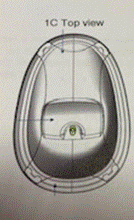
Fig. 9: Mr
Trumbo’s design 1C (interior)
144.
Returning
to Mr Biesinger, he explains that he was provided with the ODM tub by the
marketing team to consider and evaluate as a starting point for design. He did
evaluate it, including by providing it to colleagues with infants to test at
home but the feedback was not good. It also failed the compliance team’s safety
review.
145.
I
have seen notes from an innovation meeting of 3 October 2017 in which he was
told to move forward with a new design. In
cross-examination he accepted that it was a priority project. He explained that
his starting point was looking to see what else was in the market, both online
and in stores. He sets out photographs of some of those products in his report.
They include a number with bum bumps including the First Years Sure Comfort
Deluxe Newborn; the Fisher Price Whale; the Boon
Soak; the Primo Eurobath; and the Shnuggle
Mark 2. The only bum bump similar to that now in the Sit & Soak is in the
Shnuggle Mk 2. Mr Biesinger accepted in cross-examination that he may have had
the sample of the Shnuggle Mk 2 at or even before the innovation meeting on 3
October, at a 28 September 2017 meeting with Mr Tebbe (senior director of
product development) and Mr Birkert (director of product design) to review
product samples, but he could not be certain.
146.
Mr
Biesinger then describes a very thorough albeit accelerated design process over
a number of weeks, and discloses a number of renders of a number of designs. These
were created after a kick-off meeting on October 17 2017. The first version that
shows a bum bump is QMB20 (V7) on 20 October 2017 one view of which shows a
hint of a prominent bum bump when viewed from the side and above (Image 61),
but there is no internal view. In fact Mr Murphy’s analysis shows no bum bump
in V7, so there is some anomaly there. V8 and V9 do show a bum bump, and these
vary from each other.
147.
It
can be seen from Mr Murphy’s report which analyses the bumps of the various
versions of Mr Biesinger’s designs in detail, that the bum bump in V8 was both
significantly lower and considerably gentler in slope than that in V9, upon
which MCK B was based (see below). Although Mr Murphy has not overlaid a
cross-section of V8 and Shnuggle Mk 2, I have done it and the height line of
Shnuggle Mk 2 falls between V8 and V9, and the angle of slope of Shnuggle Mk 2
falls between V8 and V9.
148.
Mr
Biesinger presented three designs to the innovation team on 1 November 2017 called
MCK Tub A, B and C, based on V9, V11 and V13. They had similar but not
identical bumps, not least because V11 had a removable bump. V9 had a fixed
soap holder and it appears the bump needed to be moved back slightly to
accommodate that. In each case the bumps are quite high and sloped more steeply
at the front than the back, i.e. angled away from the child, although this is
more noticeable in V9. Mr Biesinger says that shape secured newborns better
than a gentler slope for an older baby. After that meeting it was decided to
have a fixed not removable bump, and not to proceed with the cup holder, so
version 13 was taken forward.
149.
Version
14 had the height of the V13 bump lowered slightly and the angle softened.
This, broadly speaking, is the bump in the Sit & Soak.
150.
Mr Biesinger accepted in cross-examination
that the only other physical testing of a competitor product, apart from the ODM,
was of the Shnuggle Mk 2, and that it performed well. Similarly, a focus group
was held to look at the Shnuggle Mk2. For costing the likely cost of the
product he was designing, he sent the Shnuggle Mk 2 to China as he did not have
a physical prototype until later on in the design timetable. His design was
eventually prototyped, however, at a cost of $15,000.
151.
It
was put to him in cross-examination that he had not used mannequins of babies
to develop the dimensions of his designs, as Mr Murphy did, and that was
indicative of copying the dimensions of the Shnuggle Mk 2. He said, credibly,
in my view, that he had used computer models of babies of different ages and
development rather than actual mannequins, which seems to me to be a perfectly
acceptable, higher-tech approach. I remind myself that Mr Murphy’s evidence was
that he had got his dimensions wrong in his initial prototype, despite the use
of a mannequin.
152.
Miss
Lane submits this process is not what one would expect to see in a case of
straightforward copying. Mr Biesinger said in oral evidence, “I do not know why I would have gone through
all the processes that I did, of developing multiple designs, being inspired by
multiple designs, when they were saying was the only way. This is not what was
stated. I explored many different avenues and possibilities of a design”. He
stated in cross-examination that he was intending to, and believes he did,
create a baby bath which was “different and unique and special” in multiple
ways. The question for me is whether it was different and unique and special in
the bum bump, or whether he copied the Shnuggle Mk 2 bump.
153.
In
my judgment, Munchkin has satisfied me on the balance of probabilities that the
similarities between the Sit & Soak and Shnuggle Mk 2 bum bump arise from
independent design. There are differences between the shapes of the bumps,
particularly at the sides. The general size and shape of the bump was
foreshadowed in Mr Trumbo’s earlier designs, which Mr Biesinger saw, and I am
satisfied Mr Trumbo had no access to the Shnuggle Mk 2. This is of particular
relevance, I believe, when you consider the extremely wide scope of design
freedom in both shape, size and placement of bum bumps in the wider design
corpus. Most importantly the design drawings of Mr Biesinger show, in my view,
a continual process of refinement of the height, angle and position of the bum
bump from V8 to V14 including continual adjustments to the height of the bump,
albeit within a narrow range. Whereas I accept that the Sit & Soak comes
out at approximately the same height as the Shnuggle Mk 2 (6.2cm for Shnuggle
Mk 2 and 6.35cm for Sit & Soak), both are aimed at babies of a similar age
range, the height of the bump is aimed at comfort for that range of babies, and
it is in my view more likely that is a coincidence. The angle and the position
are not the same. The shape is not the same. The Sit & Soak bump is 13.5%
wider at the bottom, 6% wider at the top and 6.8% deeper from front to back
than the Shnuggle Mk 2 bump, on Mr Murphy’s own analysis (using Mr Biesinger’s
measurements which Mr Murphy has adopted). I accept the argument that if Mr
Biesinger were simply going to copy the Shnuggle Mk 2 these continual
adjustments would not have been needed. Finally, I found Mr Biesinger to be an
honest and straightforward witness and I consider he is telling the truth when
he says he did not copy. In the circumstances of this case and this documented
design journey, I do not consider, on the balance of probabilities, that he is
honestly mistaken about this, in particular with regard to the bum bump.
154.
For
those reasons I am satisfied that the Sit & Soak does not copy Shnuggle
Design (5).
Shnuggle Design (1)
155.
As
I have found, Shnuggle Design (1) is made up of the exterior of the sides of
the lower part of the ‘tub’ and the base of the Shnuggle Mk 1. The base
includes the underneath aspect and interior shape of the bum bump as can be
seen from the photographs at Fig. 4a above.
156.
I
have set out above detail of the differences in size and shape of the Sit &
Soak bump compared to the Shnuggle Mk 2 bump, and my finding that the Sit &
Soak bump was not copied from the Shnuggle Mk 2. The differences in size and
shape of the bum bumps translate also into differences in the exterior of the
bases of those two baths. However there
is no dispute that the Shnuggle Mk 2 bump itself varies significantly from the
bump in Shnuggle Mk 1/Shnuggle Design 1. The Shnuggle Mk 1 bump is not an
island, but stretches from one side wall to another; the bump height is 4.3cm
to the 6.2cm of Shnuggle Mk 2, and is 14.43cm in depth front to back to the
115.93 of the Shnuggle Mk 2. I am satisfied that the bump in Shnuggle Mk 2, it
itself not an exact or a substantial copy of that in Shnuggle Design (1), and I
have found that the Sit & Soak although not to exactly the same extent,
because of the difference in thicknesses of the material used in the Shnuggle
Design (1) and the Sit & Soak. It is not disputed that there are also
differences in the Sit & Soak base to the Shnuggle Design (1) base because
the former has the flange construction, feet, and drain.
157.
In
terms of similarities between that part of the Shnuggle Mk 2 comparable to the
Shnuggle Design (1) and the Sit & Soak, those are
i)
The
oval base, although this is commonplace and so must be ignored;
ii)
The
width of the oval base which is almost identical (25.5 cm Shnuggle Mk 2, 25.4
cm Sit & Soak);
iii)
The
sides rising from the oval base, although this is commonplace and must be
ignored;
iv)
The
fact that the exterior of the base incorporates the internal surface of the bum
bump, although the fact of a bum bump is commonplace and must be ignored, and
the particular shape of the bum bump is a difference and I have found has not
been copied;
v)
The
concave profile of the sides of the tub as they rise from above the flange;
vi)
The
concave curve of bottom of the sides of the tub as they meet the base under the
flange;
vii)
The
angles of the front back and side curves of the tub as they rise from the base
to the line “AA”. These are analysed closely in Mr Murphy’s witness statement
and I am satisfied they are very similar. For example, the front curve rises at
angles which move from 101-123 in Shnuggle Mk 2 and from 101 – 116 in the Sit
& Soak, the side curve angles are almost identical, and the back curve
averages 110 in the Shnuggle Mk 2 and 111 in the Sit & Soak.
158.
The
differences include:
i)
The
longer length of the Sit & Soak (33.7 in the Shnuggle Mk 2 and 35.56 in the
Sit & Soak);
ii)
The
longer length, in particular, of the Sit & Soak at notional line “AA”;
iii)
The
shape and size of the internal aspect of the bum bump;
iv)
The
presence of the drain;
v)
The
presence of the feet.
159.
The
similarities in dimensions of the oval base are, in my judgment, more likely to
result from coincidence than copying. That is because there are design
constraints in the size of baby baths and both of these baths have chosen a commonplace
oval base, chosen to incorporate a commonplace bum bump, and are aimed at
babies of a similar age range. However I am satisfied that the closeness of the
profile and curves of the walls in the two baths is sufficient to give rise to
an inference of copying, and so I must go on to look at independent design of
the tub element the baths (as opposed to the bump, which I have already
considered).
160.
I
can see that Mr Trumbo’s original design had a tub with a convex, not concave,
exterior curve. Mr Biesinger’s first version recognisable as a baby bath was
V2. This had an ‘S’ shaped curve of the side walls, being convex where it rose
from the base, moving to straight walled sides but with a concave curve at the
top of the back, above where a notional line “AA” would be drawn. The concavity
of the exterior curve below where a notional line “AA” would be drawn is only
introduced in V6, and increased in V7. It is then maintained in all versions up
to V13 and the MCK models A, B and C presented to the Innovation Team on 1
November 2017. However, these versions, including MCK A, B and C, maintained
the convex curve where the sides meet the base and had visible wide feet, which
Mr Biesinger described as “our take on
Victorian claw feet baths”. These feet produced quite a different visual
effect, as they disclosed the curvature of the bath sides going into the base
in a manner which is not seen in the Shnuggle Mk 2 (or Shnuggle Design (1)),
where such a curvature is hidden by a flange. Shnuggle Design (1) does not have
such a curvature at all either internally or externally, rather the sides meet
the base at a sharp edge.
161.
The
notes of that innovation meeting of 1 November 2017 show that Mr Dunn, the
product design director, did not like the claw feet. Mr Biesinger’s evidence in
cross-examination was: “We felt that it
was a nice little modern nod to the old Victorian tubs, and by keeping that it
just felt fresh and nice, but it also related back to our Clean Cradle which is
another tub that we produce. It has little claw feet on it, so it was a way to
integrate the brand design and then we had that curved bottom. This is where
that comment comes from. He differed in his opinion on what modern design was.
We differed. We butted heads on this but, ultimately, he wanted it to come flat
down like the Shnuggle. It is only referring to the skirt coming down”. Mr
Biesinger explained that the skirt, or flange, would be important if the feet
were removed, because the rounded bottom would be left and that might cause a
danger of tipping. So in order to achieve flat sides, “it is going to have to come all the way down, and in order to
integrate the rubber feet in there, to integrate room for a plug, it has got to
sit off the ground. Therefore we created that skirt and then we have the space
kind of in between the curve and the skirt for screwposts
to go up. We need space for our drain to go in. We wanted the curved interior
because that is going to be more comfortable for a child… So, yes, we wanted
the curved interior but we had to have the flat sides, so this was really just
a necessity in order to have the smooth sides without these claw feet, so to
speak”.
162.
It was after that innovation meeting on 3
November 2017 that Mr Biesinger was told, following focus groups discussion,
that he should “Head more towards
Shnuggle based on Amazon reviews”. In V14 he made the changes he described
in cross-examination, i.e. adding the flange and hidden feet, and reached the
final design which was approved at another innovation meeting on 14 November
2017, and eventually put into production as the Sit & Soak.
163.
I
have already stated that Mr Biesinger’s evidence is that he did not copy the
Shnuggle Mk 2, but was inspired by it. I accept that is his honest belief. However,
he accepted in cross-examination that as he evolved through the designs, he
moved further away from a bucket-type upright design similar to the Tummy Tub,
to a design more able to fit a child in a more seated reclined position, and
that this was because of instructions from the marketing department and Mr Dunn,
who both used “Shnuggle” as a type of shorthand to describe what they were
trying to do. In terms of the profile and shape of the sides of the tub, which
are in part to do with comfort for the baby and in part to do with aesthetics, Munchkin
has not satisfied me that those arose from independent design. It can be seen
from Mr Murphy’s analysis of the various versions of Mr Biesinger’s design,
that once Mr Biesinger had moved from an upright tub more similar to the Tummy
Tub to a more reclined tub more similar to the Shnuggle, which he had done by
V7, the profile of the curves of main body of the tub portion did not
significantly change (putting to one side those versions which sought to
include a rinse cup).
164.
I
also bear in mind that from all the many designs of bath that I have seen in
the wider design corpus, the swooping externally concave (internally convex)
lines of the Shnuggle Mk 1 and Shnuggle Mk 2 appear to be unique and
distinctive. Ms Lane asks me to consider both Mr Biesinger’s evidence that he
was inspired by slipper baths and Mr Corcoran’s evidence that, if he was asked
to design a baby bath, he would “definitely not use [an internally] concave
[back]. I may use straight, but convex is a good solution…”. I do so, but of
the slipper baby baths I have seen, they generally had externally convex
curves, and Mr Corcoran’s evidence begs the question of why most baby baths up
to the Shnuggle had been designed as internally concave and not convex. Taking
all of the evidence into account, I consider that the inspiration Mr Biesinger
obtained from the Shnuggle Mk 2 in respect of the swoop of the sides crossed
over into copying it. Where Mr Biesinger sought to introduce differences, such
as the rounded base and feet, he was instructed to make changes so that his
designs were visually closer to Shnuggle.
Infringement of Shnuggle Design (1)?
165.
The
question for infringement is whether Munchkin has copied Shnuggle Design (1) so
as to produce articles exactly or substantially to the design. This requires
copying the whole design exactly or
substantially, and is quite different to the copyright test of infringement,
which considers whether the whole or a substantial part of a copyright work has
been copied.
166.
In
this case I have no doubt that Munchkin has not copied the whole Shnuggle
Design (1) exactly or substantially. It has only copied part of it, and that is
the shape of the sides of the tub below line “AA” and above where, in the Sit
& Soak, the tub curves externally under the flange. I do not consider that
to be a substantial copy of the whole design. The curve of the Sit & Soak
walls meeting the base is quite different to Shnuggle Design (1) as I have
described, although it is seen in Shnuggle Mk 2. The base of the Sit & Soak
is either commonplace in its similarities (in its oval shape) or is quite
different (in the external shape caused by the interior of the bum bump and the
construction of the flange, screwholes and feet which
do not appear on Shnuggle Design (1) at all).
167.
For all those reasons, the claim for
infringement of UDRs fails.
SUMMARY
Issue
(i) – Is RCD-763 valid?
No
Issue (ii) – Is the Sit
& Soak bath an infringement of the RCDs?
No
Issue (iii) – Is design right
capable of subsisting in the Shnuggle Designs as being designs for the whole or
part of an article?
Yes.
Issue (iv) – Are the
Shnuggle Designs original (excluding consideration of commonplace)?
Shnuggle Design (1), Yes
Shnuggle Design (2), (3) and (4), No
Shnuggle Design (5) and (6), Yes
Issue (v) – Are the
Shnuggle Designs commonplace?
Shnuggle Design (1), Yes at a high level of
generality
Shnuggle Design (5) and (6), Yes
Issue (vi) – Is the Sit
& Soak an article which has been made by copying the Shnuggle Designs?
Shnuggle Design (1), indirect copying in
part.
Shnuggle Designs (5) and (6) No.
Issue (vii) – Is the Sit
& Soak an article which has been made to produce articles exactly or
substantially to each of the Shnuggle Designs?
No.
Annex 1
RCD-196
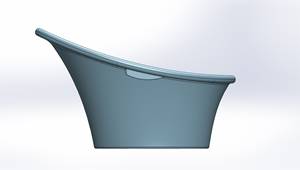
Fig 3: 0001.1
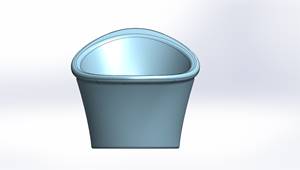
Fig 4: 0001.2
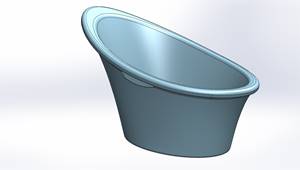
Fig 5: 0001.3
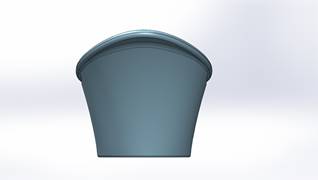
Fig 6: 0001.4
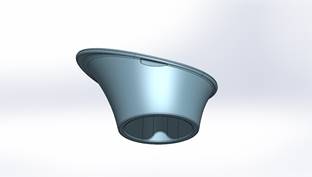
Fig 7: 0001.5
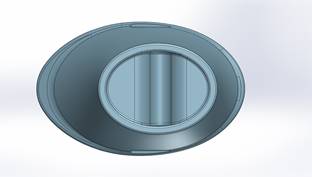
Fig 8: 0001.6
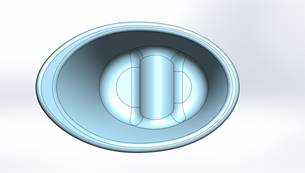
Fig 9: 0001.7
Annex
2
RCD-763
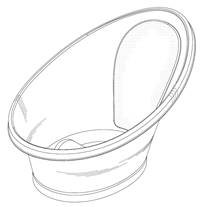
Fig
10: 0001.1
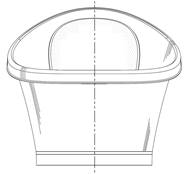
Fig 11:
0001.2
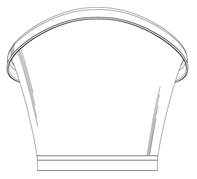
Fig 12:
0001.3
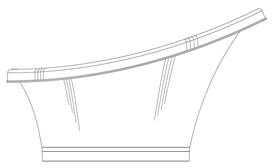
Fig 13: 0001.4
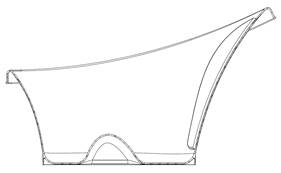
Fig 14: 0001.5
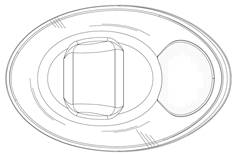
Fig 15: 0001.6
Annex
3
UDRs
In each case, what is
claimed in the relevant design is not coloured pink, and what is excluded is
coloured pink.
|
Design |
Example images |
|
Design (1) The external shape of sides the Mk1 below the line
marked “AA” on page 1 of Annex 5. Such external shape includes the generally
oval horizontal cross-sectional profile of the sides upwards from the base to
the plane “AA”. |
|
|
Design (2) The shape of the whole of the Mk2 excluding the roll
top, the padded backrest, and the feet, as shown on page 2 of Annex 5. |
|
|
Design (3) The shape of the sides and underside of the design
described at (2) above, below the line marked “AA” on page 3 of Annex 5.
|
|
|
Design (4) The design described at (3) above, excluding the
area marked “B” on page 4 of Annex 5. |
|
|
Design (5) The design described at (2) above, below the line
marked “BB” on page 5 of Annex 5.
|
|
|
Design (6) The design described at (5) above, excluding the
area marked “B” on page 6 of Annex 5. |
|
It is Shnuggle’s
case that Shnuggle Design (1) is the external shape of the sides of the
Shnuggle Mk1 below the line marked “AA”. This shape was used as the external
shape of the sides of the Shnuggle Mk2. Hence Shnuggle relies upon Shnuggle
Design (1) as incorporated in the Shnuggle Mk1, with the consequence that
design right will expire in relation to this design at the end of 2024 and
become open to licences of right at the end of 2019 (see sections 216 and 237
CDPA).
It is Shnuggle’s
case that Shnuggle Designs (2) to (6) all relate to parts of the Shnuggle Mk2
and include or consist exclusively of parts which are new to the Shnuggle Mk2
and which are not found in the Shnuggle Mk1. The Shnuggle Mk2 was launched in
early 2015 therefore
any unregistered design right in respect of Shnuggle Designs (2) to (6) will
expire at the end of 2025 and will become open to licences of right at the end
of 2020.


